New Growth Projects
We're supporting youth volunteers to help protect Victoria's biodiversity and environment.
To learn more visit New Growth Projects
Stories in the Spotlight
A successful working bee was held at the Long Gully Community Garden in December with thirteen environmental volunteers coming together to learn about raised garden beds and how to construct them.
What made this event special was that it is part of a place-making process, led by Regional Victorians of Colour and Long Gully Neighbourhood Centre, to create welcoming spaces for newly arrived migrants and other members of Bendigo’s multicultural community. The working bee is an example of a positive activity contributing to greater inclusion and a sense of belonging for Bendigo’s Karen community.
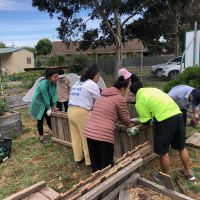
There were four key elements that underpinned the success of this event;
- focusing on an activity (growing food) which people were doing in their home country; especially growing traditional ingredients that are not commonly available in Victoria.
- Engaging a member of the Karen community to recruit and organise participants; valuing their expertise and community connections and ensuring support for participants before and during the event.
- culturally appropriate program design; identifying that the basic unit of new migrant communities is the family, so ensuring that children and older generations were welcome and providing culturally relevant catering for the event, which was from the Karen community.
- Providing transport to and from the event.
At the end of the working bee, participants had started construction on two new raised bed gardens for use by groups and individuals on the waiting list for personal garden plots at the Community Garden. Participants felt welcomed into the community garden space and understood why raised beds were important to prevent contamination from Bendigo’s past mining activities.
All the volunteer participants were from the Karen community of Bendigo. Some didn’t speak English very well, but amongst the group there were people who could translate. Chatting with participants throughout the morning, it was clear that people came for different reasons; to meet people, satisfy curiosity about the gardens and to work together. Each participant reported getting something beneficial from the experience; it was an enjoyable, relaxing activity, an opportunity to learn and to come together.
Volunteering managers can learn from this example of how culturally diverse communities can be supported to participate as volunteers and implement these strategies in groups across the region.

This event was supported by the Department of Energy, Environment and Climate Action with funding through the Regional Environmental Volunteering Coordination (REVC) trial. Volunteering Loddon Mallee joined the activity as evaluator. The Long Gully Community Garden is an outreach program of the Long Gully Neighbourhood Centre, who employs a garden facilitator to lead the activities there.
The collaboration between Regional Victorians of Colour, Volunteering Loddon Mallee, Department of Energy, Environment and Climate Action and the Long Gully Community Garden will continue by providing support for community garden participants to step into formal environmental volunteering roles, spring-boarding off this foundational place-making activity.
For the past few years, the Wedderburn Conservation Management Network has partnered with Lifely's Our Choice Group on environmental volunteering activities, focusing on day outings to spring soaks located near Wedderburn.
Lifely is a disability service provider operating in the Loddon Mallee region and ‘Our Choice’ is a social day program that supports adults with a disability to get out and about in their community, have new experiences and connect with other people. Activities are tailored to the groups' interests but generally incorporate trips to regional towns, outdoor activities, sports, recreation, creative arts, gardening, cooking and more.
Environmental volunteering is an activity that ‘Our Choice’ participants enjoy. They have participated in tree planting activities and other sustainability initiatives at the at the spring soaks near Wedderburn with local property owner and Wedderburn Conservation Management Network member Trudy Nelsson.
‘Our Choice’ benefits for participants
According to Alice Lewis, ‘Our Choice’ leader at Lifely, the activity days have promoted better physical and mental health for all participants. “Everyone on the bus on the way home is always loud and in good spirits, feeling energised from being outside and being part of something. It gives a sense of connection to others in the community and environment.” Alice says that after three years of plantings and watching the trees grow, the participants have a sense of satisfaction and confidence. “Our group hope that we can continue to volunteer in nature for years to come.”
The group outings have fostered a strong sense of community and camaraderie among the participants. They share laughter, support, and a common purpose as they work together on environmental projects.
Over the three years of volunteering, the participants have had the opportunity to witness the tangible results of their efforts. They have experienced a deep sense of pride and accomplishment from planting trees and watching them grow over time.
When organisations prioritise inclusivity and make reasonable adjustments to accommodate the diverse needs of people with disabilities, participating in environmental volunteering becomes an enriching and empowering experience. The key lies in treating them with respect, dignity, and a welcoming attitude, fostering a sense of belonging and value within the volunteering community. In such an inclusive and supportive environment, individuals with disabilities find the space to thrive, build connections, and make a positive impact, nurturing a sense of purpose and accomplishment in their environmental volunteering journey.
Victoria’s 213,532 environmental volunteers contribute more than 1.9 million hours of unpaid work each year to protect and enhance nature. The economic contribution is projected to be $84 million annually. In the Loddon Mallee region, over 20,000 people volunteered for over 104,000 hours last year, contributing over $4.8 million to the Victorian economy. Volunteering is great for the environment, but volunteering for nature is also great for our wellbeing. There are lots of different ways to get involved and you can find out more on our interactive map.
‘Lost’ Victorian bird rediscovered by volunteer
The Mallee Whipbird hadn’t been seen in Victoria for at least four decades until a volunteer recorded its song in the Big Desert Wilderness Park late 2022. The recording was captured during one of 10 week-long field surveys, conducted as part of the Threatened Mallee Birds project.
The project aims to increase the understanding of the distribution of 10 endangered Mallee bird species to inform future management. Lead researcher for the project, Dr Simon Verdon from La Trobe University, orchestrated the field surveys throughout 2022. Enthusiastic volunteers were dropped off at dawn in isolated locations in Big Desert country in Victoria and Ngarkat Conservation Park in South Australia. Volunteers were equipped with safety devices and the tools to assist their bird identification tasks, including iPads loaded with bird field guides and bird calls.
It was a huge undertaking, and Simon emphasises the importance of the 60 volunteers that contributed throughout the project. There were 54 volunteer surveyors and six volunteer camp helpers, in addition to three full-time surveyors. “I still can’t fathom what we achieved together. Over 6,000 kilometres of bird surveys, 30,000 birds recorded, and a species re-discovered in Victoria after decades without a sighting. And all of it was down to our efforts as a collective.”
“Without exaggeration, if I tried to do this without volunteers I would still be out there now, still surveying, one year later on. But that was never an option, so instead I would have settled for less field time and less data, which would have led to worse outcomes for nature.”
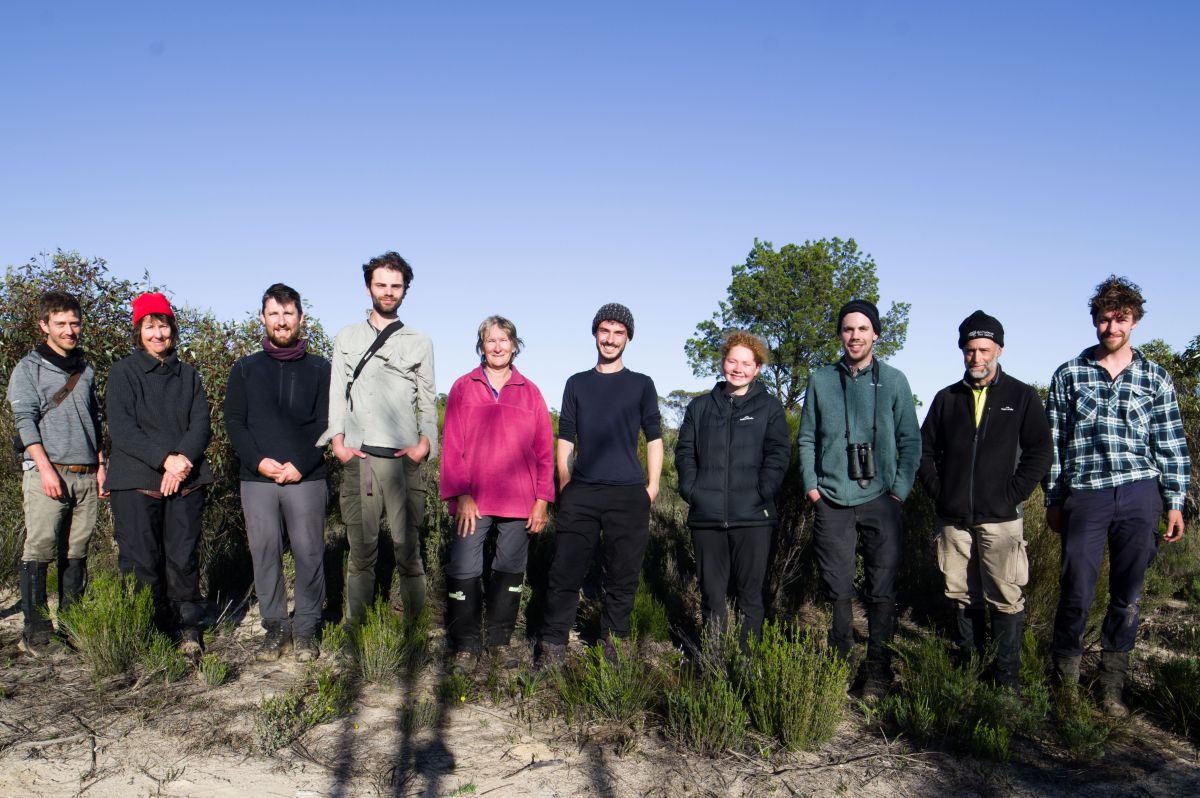
Mallee Whipbird Volunteers. Credit Will Mitchell
A wide range of volunteers were involved in the project, some of whom came on one trip and then signed up for another because it was such a great experience. The surveys allowed volunteers to learn new skills or improve their existing skills in bird identification. It was also a great opportunity for volunteers of all ages, like 15-year-old Leo and his dad Phil teaming up on one of the surveys.
Other volunteers have ‘caught the twitching bug’ and continue to pursue bird watching for pleasure. But Bryony Margetts has taken this a step further and is starting her PhD on the Whipbird next year.
Simon never expected the project to rediscover a lost species, but that’s exactly what two volunteers did when they recorded the call of the Mallee Whipbird, one in South Australia and another in Victoria. Lachlan Wild, a 24-year-old volunteer from Bendigo, captured the Victorian recording and couldn’t be more excited.
Lachlan volunteered for the project as he wanted to experience a new natural environment and gain hands-on experience in conservation work. He also enjoyed meeting a variety of people from different backgrounds who are all passionate about protecting the environment. “I gained a variety of skills in participating in the surveys and working in remote environments, which have been helpful in my studies and understanding my future career path.” Lachlan is currently working on a Master of Environmental Management but has taken a year off to volunteer at the Broome Bird Observatory. “Volunteering on this project helped cement my interest in conservation, particularly of threatened birds.”
Simon is certain that the Mallee Whipbird was only recorded because of the volunteers. “We made two records in total, both by volunteers. The Victorian record was made in the last week of surveys, after more than 3,000 hours of surveys.”
“There is a direct line from the data we collected to on-ground actions, so the time and effort people spent walking the bush and collecting data was not in vain and was not just for fun. We contributed to something larger than ourselves and I think that is part of the reason it was so rewarding for so many people.”
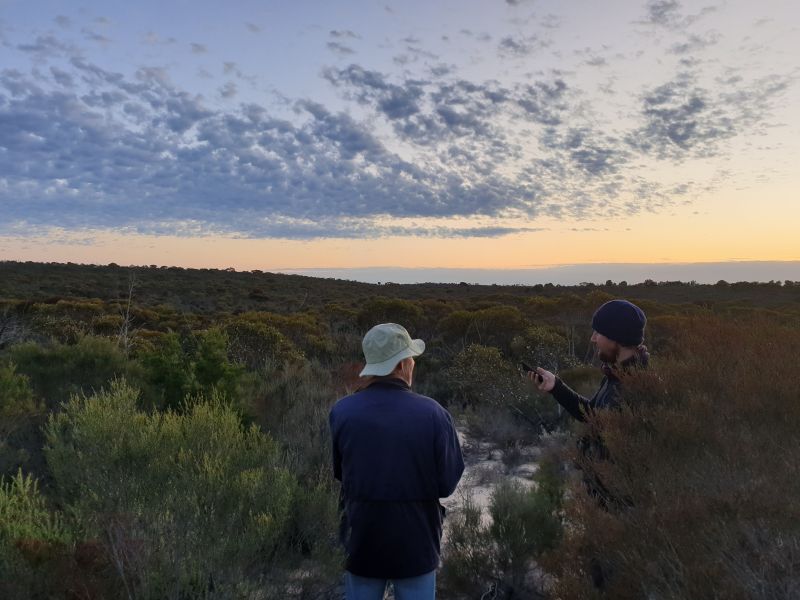
Surveying at dawn. Credit Deb Verdon
The Threatened Mallee Birds project is supported by the Mallee Catchment Management Authority, through joint funding from the Australian Government’s Environment Restoration Fund, the National Landcare Program, Murraylands and Riverland Landscape Board, and the Department for Environment and Water SA.
Dorothy Reid - a lifetime of volunteering
Growing up on the southern edge of the Big Desert, Dorothy Reid, 84, always noticed the wildlife, insects and plants around her. While living on the farm near Birchip in 1988, Dorothy helped establish the Birchip Landcare Group. Since then, she’s held many roles, including Vice-President and Secretary – all alongside her 40-year-long role as Secretary of the Historical Society.
Some early Landcare activities included
- a community planting day at Pump Hut Reserve with over 50 people of all ages
- roadside fencing to protect rare and endangered plants from grazing sheep
- a project to protect mini daisies, Broughton peas, hop bushes and quandong trees growing in this area. These plants are still thriving thanks to the fencing. (Rumours persist of local quandong jam being available to those in the know!)
Water for Wildlife
Birchip Landcare Group was a voice for the community via Catchment Management Authority Working Groups. This included a role in the Wetland Evaluation Team, run by Wimmera Mallee Water to determine where to put environmental water when the pipeline was constructed. As a result of Landcare’s advocacy, the project delivered 3000 megalitres for the local recreation lakes and 1000 litres for wildlife.
This was a significant outcome for the area as the Northern Mallee pipeline hadn’t considered the consequences for wildlife of decommissioning the water channels. Dorothy reflects, “There was no water for wildlife anywhere. I heard stories of bees stinging sheep at water troughs, and foxes and cats sitting under troughs waiting for a bird to sit there. I thought, well, something's got to be done.”
The Pipe Right Group was formed with hundreds of members, all determined to support the fight to make sure the piping was built to enable wildlife survival.

Like to join Landcare?
As with many volunteer organisations, Birchip Landcare Group struggles to attract new members. The rise of sporting opportunities pulls away the younger people, and of course community sport requires a large commitment of volunteer time from families, making it harder to attract participation in other groups like Landcare.
To Dorothy, the Buloke Shire’s Citizen of the Year 2015 recipient, Landcare is so much more than tree-planting - there is weeding, fencing remnant vegetation, applying for grants to eradicate pests and an important role advocating for the local environment.
“[Landcare] is such a good movement, we need to care for the environment and do as much as we can. [Volunteering] is more rewarding than if you just sit back and do nothing. There's a job to be done and while I still have my marbles, I will keep contributing,” said Dorothy.
Dorothy is also proud of her family’s Trust for Nature covenant of 75 acres, which protects habitat on private land, allowing wildlife and native plants to thrive.
We thank Dorothy for her life-long contribution to nature and her community and encourage others to reap the rewards of environmental volunteering.
If you are interested in getting involved in Landcare, please click here.
The Plains-wanderer Song Meter Program aims to turn a single call into a shared chorus.
Meeting with two student representatives from Tempy PS on a sunny Mallee morning, we learnt a lot about the passion and enthusiasm of students for their local environment and their care for local endangered species – the Malleefowl.
Students Baxter (Grade 5) and Memphis (Grade 6) were keen to share their knowledge about the ‘pretty cool’ bird found in the surrounding semiarid mallee scrub regions.
“They have ‘temperature-telling beak thing’ because they have to keep their nest at 33 degrees at all times for the eggs to incubate”, explains Baxter. “But we're not sure what measures the temperature, no one's really sure but they seem to know [the temperature], somehow”, adds Memphis.
The Malleefowl project was a partnership between Victorian Malleefowl Recovery Group (VMRG), Mallee CMA and South East Mallee Landcare Network, and involved Tempy PS students undertaking citizen science activities and learning to protect the Malleefowl. On field trips students discovered two active nests, learned about the diet of the bird and how to identify tracks and scats.
The students have learnt the importance of looking after the unique mound building birds, “There's not many left and we need to protect them. And they're so different, like you can't find them anywhere else.”

Established in 1910, Tempy Primary School is a small school located in the beautiful Mallee region of Northwest Victoria. Outdoor activities are part of the daily routine including physical education, gardening and environmental studies. The school focuses on creating and maintaining links with community bodies such as the South East Mallee Landcare Network and Parks Victoria.
Tempy PS was the 2021 winner of the Woolworths Junior Landcare Team Award which acknowledges a school, youth organisation or young community Landcare team that contributes to raising awareness, sharing knowledge, and promoting participation of Landcare amongst young people.
The children have great ideas for protecting the Malleefowl into the future, such as creating more reserves and wildlife corridors, and encouraging farmers to plant more trees. Other suggestions include road signs encouraging drivers to slow down because there are Malleefowl crossing the road.
With the philosophy that it is everybody’s job to look after the environment, the students of Tempy PS are demonstrating to their families and communities the importance of contributing back to the local environment for the benefit of future generations and the value of volunteering for nature.
The bustling streets of suburbia may not be what comes to mind when picturing the native habitat for one of the State's smallest animals. However, the green corridor of Banyule has become known as the home of the sugar (Krefft’s) gliders thanks in no small part to the efforts of the Montmorency Community Group and the Banyule’s Sugar (Krefft’s) Glider Project.
Run entirely by volunteers, this community group and their project have been instrumental in monitoring, protecting and ensuring the continued growth of Banyule’s Sugar Glider population.

After a successful Pick My Project grant, the group expanded its reach and now actively monitors its 400 boxes in Banyule on both public and private land.
Since 2016 the group has been conducting 1-2 census days a year with the most recent being carried out in March. The information gathered on these census days and through active field monitoring is collated into a report that is later provided to the local council.
The report is used to highlight the importance of urban wildlife corridor connections and assist council in future land management planning decisions.
Census coordinator Charlotte Hall said the program was “a great way to get involved and have an impact on the future on conserving local biodiversity” and that joining the group has been a fantastic way to meet new people in the community.
Their most recent report proved instrumental in assisting council in the development of the Banyule’s Biodiversity Plan and Urban Forest Strategy and showed that 15% to 25% of the nest boxes in the area are occupied .
Over the years the group has forged strong connections with the local council and works closely with the council's local biodiversity team. “The Banyule Sugar Glider group is an example of how criticalenvironmental volunteer groups are in assisting Council decisions on how to support local wildlife and overall biodiversity in Banyule. Their commitment and consistent approach is SO valuable.” Paul Davis – Biodiversity Advisor Banyule City Council.
For more information visit: https://www.transitionmonty.org/about-mcg.html
Image credit: Chris Cook

This Citizen Science Month we’re recognising the incredible contribution volunteers make to citizen science – a unique and powerful form of volunteering.
Citizen scientists make a meaningful impact on Australian scientific research and environmental decision-making by collecting valuable scientific data. One of the ways they’re doing this is through the City Nature Challenge.
From Friday (28 April) to Monday (1 May), participants are invited to find, photograph, and document the native fauna and flora in their neighbourhoods – submitting their findings to the iNaturalist app.
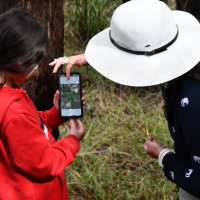
Image credit: Doug Evans
In 2021, an astounding 2,035 species were identified in Greater Melbourne.
Given this was the first time many participants had used the iNaturalist app, the findings are remarkable. One of the Challenge participants said, “This was the first time I'd used the iNaturalist app. It's addictive once you get the hang of it. I found the City Nature Challenge was a good catalyst to begin using it.”
One of the methods that contributed to the success of the challenge was the organisation of 43 expert-led guided walks. The guided walks attracted over 670 participants, bringing together professional ecologists, local experts, reserve volunteers, novices, and families to share discoveries of nature in and around where they live.
“The opportunity to encourage more people, and families in general, to become citizen scientists and monitor and record what is going on around them is most worthwhile,” one of the walk participants said.
How to get involved:
If you’d like to get involved this year, you can contribute to the challenge directly by using iNaturalist to log your observations of the wild plants and animals you can find in your local area – a nearby creek, a local reserve, or your own backyard – any time from Friday 28 April to Monday 1 May.
You can also contribute to the Greater Melbourne project – a collaboration among 27 councils and 9 organisations by visiting Victorian Environment Friends Networks and logging your observations there.
Watch the official 2023 City Nature Challenge video to view some of the amazing observations of wild plants and animals that people around the world have made in previous challenges.
International Volunteer Day 2023
International Volunteer Day is an opportunity to thank all the volunteers caring for nature throughout Victoria.
The theme this year is 'If Everyone Did' highlighting the power of collective action.
Thank you very much for all that you do to benefit the environment and your communities across the state.
National Volunteer Week 2023
Greening Melbourne parklands
The Urban Bushland Initiative (UBI) is a Melbourne-based not-for-profit-organisation created by young people to green urban areas.
Founded by Alex Paporakis, UBI is led by a committee of six people under 30, dedicated to revegetating urban parks and increasing native biodiversity within Melbourne's north-west.
Through community planting days that have attracted approximately 150 volunteers to each event, the group has planted thousands of indigenous trees and plants.
Hear from Alex about why he began volunteering and why he’s encouraging others to get involved.
Creating a community space for Beechworth
Landcare volunteers with a vision have made a difference for their community in Beechworth, by transforming an underused area of parkland into a space for everyone to enjoy.
Nicki Munro is one of approximately 50 volunteers involved with the Beechworth Urban Landcare and Sustainability Group who contributed almost 2,000 hours last year to a range of local environmental projects.
Nicki has been an active member of Beechworth Urban Landcare and Sustainability since moving to the area about seven years ago and is proud of what the group achieved through its work on the Beechworth Bush Botanic Garden, and revegetation of ‘the Glades’ on the edge the Lake Sambell.
Hear from Nicki about the difference that the volunteering project has made to the community.
Growing seedlings for Melbourne’s west
A social enterprise in Melbourne is working to address climate change by growing thousands of native seedlings into mature trees for Melbourne’s western suburbs.
Walter Villagonzalo is one of approximately 40 volunteers involved with the Canopy Accelerator Co-operative Limited, which is establishing community-owned tree nurseries across the City of Wyndham.
With the aim of delivering increased tree canopy cover for Melbourne’s west, the group supplies seedlings and trees to organisations and businesses for tree planting projects.
Hear from Walter about why he joined the group and how the volunteering has connected him with his community.
More stories from our volunteers
International Volunteer Day 2022
National Volunteer Week 16 - 22 May 2022
To celebrate and promote the work being done by our environmental volunteers during National Volunteer Week, we have compiled a selection of fabulous stories about volunteering groups and projects.
Victoria's environmental volunteers span all ages, cultures, and work across a range of groups and organisations. From wetland restoration to engaging youth in citizen science, urchin removal to propagating, volunteers are doing impactful and inspiring work in and for our environment.
We start off with the video below showing the environmental volunteers working underwater. There are more stories available under the video in the drop down boxes underneath.
While snorkelling in the summer of 2021, a group of community volunteers with Marine Care Ricketts Point (MCRP) noticed a significant decline in the amount of seaweed growing in the southern part of the Port Phillip Bay marine sanctuary.
Areas that were once rich with seaweed off the bayside Beaumaris coast were now bare rock and covered in purple-spined sea urchins. Urchins impact the seagrass and kelp forest habitats, which are important ecosystems for fish and other marine species.
Concerned for the underwater ecology at Ricketts Point Marine Sanctuary, MCRP alerted Parks Victoria, and with support from the Coastcare Victoria Community Grants program, a project was established to counter overabundant urchins in the area.
With oversight from Parks Victoria, the group of 16 completed the first two urchin culls in February and March this year.
Ian O’Loughlin, a volunteer with MCRP and snorkel leader, was keen to get the cull underway, as it had previously been cancelled due to poor weather.
‘I enjoy taking people out snorkelling and showing them what a great place the marine sanctuary is, how much life is in the water and on the rock ledges.
‘It’s important to be involved so that the sanctuary continues to be a beautiful and healthy place for future generations to relax and enjoy themselves,’ Ian said.
The group received a detailed brief from Parks Victoria to explain how to effectively bring a marine system back into balance by the safe and humane removal of the urchin barren, supported by scientific research.
Despite some choppy conditions, it only took about one hour to complete the removal of 2475 urchins.
Fellow volunteer and snorkel leader, Toni Roberts, was also involved. Toni values the strong sense of community connection and mutual appreciation of the marine environment gained by volunteering at Ricketts Point.
‘It is a satisfying experience to be working together to rebuild the ecosystem, ensuring a healthy future for the area.
‘And we were very careful not to damage the surrounding rocks or plants during the cull,’ Toni said.
Parks Victoria will monitor the effects of the February cull. The MCRP volunteers are hopeful this activity will allow the seaweeds to re-establish and provide habitats for fish and other species.
For more information visit https://marinecare.org.au/
A group of South Gippsland coast protection volunteers are more likely to be armed with phones than wetsuits these days, using a new rabbit scanning app to help stop pests damaging vegetation along the delicate coastline.
To minimise the rabbit impact on the coast’s native fauna and flora, Corinella Foreshore Reserve volunteers, with the support of Bass Coast Landcare Network and other local volunteers are working together to improve the biodiversity of their local reserve.

Through the support of the Victorian Government’s Coastcare Victoria Community Grants Program, in early 2022, the group took an online class on how to use the RabbitScan app. Using mobile technology, volunteers can accurately map rabbit activity along their coast, to improve pest management and weed control efforts.
Volunteers are also involved in field days where they hand-weed sensitive areas to preserve indigenous plant species. Local resident Barbara Oates was more than happy to give her time to care for the natural environment, feeling a strong sense of responsibility to ensure the community improves the reserve for future generations.
‘It is very rewarding to see the results of your volunteering, to see the weeds being replaced naturally by native grasses on a targeted patch,’ Barbara said.
Sharing her knowledge with members of the community to broaden their understanding of the local geology, flora and fauna is a highlight for Barbara. ‘Being thanked by a person passing by, while working on the reserve, makes the effort worthwhile,’ she said.
After moving into the area in 2020, Janette Eriksen joined the group to help with its weeding activities.
‘Having lived my life in various parts of rural NSW, I knew so little about what was indigenous to this area. It has been informative and fun,’ Janette said.
‘I see a future where young people can roam the bush with the look of wonder on their faces. That’s what inspired me to be involved.’
Through mobile technology and community engagement, the reduction in pest and plant-animal pressure is allowing the regenerated areas to become alive with wildlife and matured vegetation at Settlement Point and the Northern and Southern Precincts.
To find out more visit https://www.corinellaforeshore.com.au/
Photo credits : Corinella Foreshore (above) Jennifer Anne Date. Below: Grassland meeting; Barbara Oates

In times gone by, helping preserve local wetlands may have required a high tolerance for mud and some thick gumboots. But in the southern Grampians today, a group of local volunteers is mixing the dirt with hi-tech data downloads and desk time.
For the past 8 years, volunteers have been supporting local wetlands restoration works by the Nature Glenelg Trust (NGT) with a range of technology-driven tasks that are helping provide real-time data on the health of the ecosystem.
Each month, volunteers monitor the wetlands using AudioMoth acoustic loggers to record sounds from frogs and birds. They then use motion-capture cameras to capture vision of wading birds.

After buying a bush property at Gariwerd, Kylie Rose and Andrew Taylor have been volunteering at the nearby Walker swamp. The couple now set up and maintain the audio and video monitoring equipment around the swamp, regularly trekking out on site with the motion-capture cameras and Audiomoth recorders, changing their batteries and retrieving data cards.
Once the data is retrieved, other local volunteers unable to participate in the fieldwork collate, examine and identify species of birds and frogs on their computers. This data is then provided to NGT and has been vital in helping its local conservation efforts.
‘Getting out into the swamp and seeing endangered birdlife, such as brolgas returning to the wetlands is a highlight of being involved,’ Kylie said.
In addition to their activities at Walker swamp, the couple also participates in local working bees, and enjoys getting together with NGT staff and other volunteers.
‘I believe that volunteers in local communities can make a real difference to conserve and restore native habitats and keep our planet rich and healthy,’ Andrew said.
‘I love spending time with other like-minded people, I always learn so much from them – environmental volunteers are awesome!’ Kylie said.
Funded by the Victorian Government through the Parks Victoria Volunteering Innovation Fund, the Grampians citizen science monitoring program is providing a wider understanding and awareness of the Gariwerd landscape and the ecological responses to hydrological wetland restoration work.
To get involved in the program, email lauren.brown@ngt.org.au
Photo credits: Volunteers monitoring (above) credit: Kylie Rose and below Walker Swamp with the Serra Range of the Grampians in the background, credit Andrew Taylor

Approximately 500 Victorian volunteers have spent the most recent three-month platypus breeding season donating their time to help map populations of this much-loved threatened marsupial.
The volunteers visited around 2,000 different sites across the state from August to November 2021 as part of pioneering national project, The Great Australian Platypus Search.
The project is the brainchild of national environmental charity, Odonata, and has been created to help scientists better understand the movements of and threats to platypus populations.
There is mounting evidence showing a decline in the platypus numbers across Australia due to habitat loss, drought, climate change, and last summer’s bushfires.
Volunteers visited the designated sampling sites to gather eDNA – traces of wildlife DNA - and use a specially-created Great Australian Platypus Search app to upload data about their sample and site.

Scientists then use volunteers’ data to develop a comprehensive map of platypus populations.
Over the past 12 months, Victorian volunteer Kate Shillabeer has been exploring and recording data in the app from her local area of Porepunkah in Victoria’s high country and also in coastal Mallacoota, while on holidays. After witnessing the 2021 bushfires, Kate felt the need to get actively involved in protecting Victorian ecosystems and the native animals that live in these environments.
‘We need to shift the way we think about the planet, and this starts by getting involved and making positive changes,’ Kate said.
Kate says that being involved in the platypus search gives her hope that platypus breeding areas in Victoria and across Australia will be recognised and more work can be done to protect them.
‘It feels great to be able to contribute to research,’ Kate said.
‘Knowing that my backyard may have a thriving platypus population makes me more mindful of the development happening in the area and how to protect the natural environment.’
Data from volunteers like Kate will help scientists fill a critical gap in knowledge of the species so that this unique and iconic mammal can be better protected for many years to come.
In 2021, The Great Australian Platypus Search is a collaboration between Odonata, La Trobe University, EnviroDNA, WWF Australia, Environment Education Victoria, and the Department of Environment, Land, Water and Planning (DELWP).
Register your interest as a volunteer for future iterations of this project or join the community of Great Australian Platypus Search citizen scientists here: https://www.facebook.com/groups/873161846938669
Photo credits: above PlatypusSPOT and below Volunteers at Little River in Balliang; Charles Singleton

For four days last spring, scout groups across the state supported by hundreds of parent volunteers competed against each other to make the most and most interesting environmental observations as part of The Big Scouting Bioblitz.
Christine Almaraz, a volunteer scout leader in 1st Doncaster East, took her Cub Scout unit out into the natural environment to collect records of plants, animals, and fungi as part of the Bioblitz.
Having first-hand experience of the benefits of being involved as a Scouts volunteer after her son Daniel joined Joey Scouts, Christine wanted to give her time to helping youth develop their sense of character and purpose through environmental volunteering.
‘It’s important to allow youth to engage with the environment, to see the life we have in our parks,’ Christine said.
With support from Parks Victoria, Scouts aged 5 to 26 from across Victoria were involved in the November 2021 Bioblitz by collecting and uploading evidence of their discoveries to the national biodiversity database, Atlas of Living Australia, using the iNaturalist mobile app.

By sharing photos and sound recordings, both the scouts and also parent volunteers furthered their understanding and awareness of the fauna and flora in their surrounding natural environments.
Christine encourages all parents to volunteer with Scouts Victoria and to participate in initiatives like the Bioblitz.
‘Knowing that I have made a small contribution to youth developing lifelong skills is a wonderful feeling,’ Christine said.
‘Also, teaching youth what to do now to protect the environment, will help the future.’
When scout leader for 5th Northcote, Simon Vincett, heard about The Big Scouting BioBlitz, he knew his scouts would love it. It was outdoors, competitive and a group activity using mobile phones was an irresistible combination for the scouts.
With more than 300 observations, the group not only won prize money to buy new tents, but the scouts discovered a local wetland, learned the names of dozens of species in their area and contributed their data as active citizen scientists.
‘The scouts didn’t think of themselves previously as environmental volunteers,’ Simon said.
‘What a great use of the abundant energy of young people, to get them recording the diversity of species in their local area.’
For more information visit www.scoutsvictoria.com.au
Photo credits: Both photos show Scouts during the Bio Blitz; credits Simon Vincett

Creating bird boxes, planting at the new Elsternwick Park Nature Reserve and providing food for the little penguins of St Kilda Pier are just some of the ways young volunteers engage in a pioneering new partnership between Port Phillip EcoCentre and youth mental health service Headspace.
The EcoCentre is a St Kilda based not-for-profit that promotes self-development and sense of community through environmental sustainability and community action.
A collaboration between Headspace Bentleigh and the EcoCentre, with support from Parks Victoria, the 10-week partnership program provides opportunities for young people to volunteer in nature and explore their connection to land, identify possible career opportunities and establish pathways for future environmental volunteering.

Tasma Eddy, an Urban Planning university student from South Yarra, said she enjoyed volunteering with the program and immersing herself in nature each week.
‘The EcoCentre is such an awesome organisation with many knowledgeable people and engaging activities,’ Tasma said.
Like many other young people, Tasma asserts being in and volunteering for nature improves her overall health and wellbeing.
‘My passion for environmental volunteering stems from my love and care for nature - being in and volunteering for nature improves my wellbeing and sense of achievement in life,’ she said.
‘My hope for the future is that everyone does their part to actively take care of nature and to achieve a sustainable future.’
After completing the program, Tasma was inspired to continue giving her time by becoming a volunteer with the Stonnington Youth Services’ Expressions Program, helping with events aimed at youth aged 12 to 25 years with a focus on diversity in the Stonnington Council community.
For more information about Port Phillip EcoCentre visit:https://www.ecocentre.com/
For more information about the program, visit Headspace: https://headspace.org.au/headspace-centres/bentleigh/
Photo credit: Alex Hoffman and Tasma Eddy at Port Phillip EcoCentre - credit Tasma Eddy
Since 1989, the combined efforts of the Victorian Government and a host of conservation partners has prevented the extinction of this charismatic bird.
The Helmeted Honeyeater Recovery team - DELWP, Parks Victoria, The Friends of the Helmeted Honeyeater, Port Phillip and Westernport CMA, Melbourne Water, Trust for Nature, Birdlife Australia, Greening Australia, local councils and universities, and Zoos Victoria – is working together to save this iconic bird from extinction.
For the past 33 years, hundreds of dedicated Yarra Valley locals have been giving their time to protect Victoria’s critically endangered bird emblem as part of the Friends of the Helmeted Honeyeater group.
When the volunteer group was first established, there were just 50 Helmeted Honeyeaters left in the nearby Yellingbo Nature Conservation Reserve, about 50km east of Melbourne.
In March 2020, the friends group estimated there were about 240 birds left in the wild.

Supported by a Victorian Government Community Volunteer Action Grant to help volunteers re-engage with environmental volunteering after the significant impact COVID safe settings had on their ability to get together, the group is back in full swing and is calling for more volunteers to join in with its ‘think global, act local’ conservation efforts.
Volunteers can lend a hand at the group’s nursery, where they grow native plants for replanting across Yellingbo, or join the ‘Seeds and Weeds’ group planting days across Yellingbo. New volunteers can also get involved via citizen science, participating in bird monitoring activities across the area and other bespoke activities, like a feeding program.
Despite huge improvements to habitat conditions due to the friends’ efforts, the resultant food supply is not yet keeping pace with the demands of the increasing Helmeted Honeyeater numbers.
Volunteer Rachel Potter is currently part of the feeding program group that’s providing a nectar food mix to the colonies of Helmeted Honeyeaters in an area where the habitat is degraded and does not provide sufficient food. While in Yellingbo, Rachel and her fellow volunteers also record observations on which birds they see and report any potential health issues or injury concerns to the program’s ornithologist.
Rachel finds working alongside the group of passionate and dedicated volunteers in Victoria’s beautiful bush setting extremely rewarding.
‘My passion for being involved in the project is fuelled by the other amazing volunteers who are out there, doing extraordinary things,’ Rachel said.
‘Every little action matters, and you can make your little actions as numerous as you want to, or as much as you are able,’ she said.
To join Rachel and the other volunteers, https://www.helmetedhoneyeater.org.au/get-involved/volunteer/
Photo credits: Marcia Riederer

A proud grassroots movement in Southern Otway is using collective action to protect and restore the Kennett River region. Volunteers are working together to tackle environmental weeds and replant lost indigenous vegetation to create an enjoyable and educational space for locals and tourists for many years to come.
Kim Stevenson, from Brunswick Heads, volunteers with the Southern Otway Landcare Network (SOLN) in a group known as the Shrub Club Community Nursery. Learning about the plants indigenous to the area and their importance for sustaining local ecosystems, ensures Kim and the other volunteers can support and restore the biodiversity of the fauna. The Shrub Club collects local plants that are propagated via cuttings and seeds and used for large-scale revegetation projects in the area.
‘It is wonderful to see the success of our plant propagation efforts and how we are contributing to improving the ecosystems,’ Kim said.

Making connections with other volunteers, as well as those connected to Landcare groups like Otway Ocean Care and Southern Otway Beekeepers Club (SOBee) is an important part of SOLN’s community engagement.
‘Landcare provides a framework and support for individuals to contribute to caring for country, for social connectivity built around place and the environment,’ Kim said.
With support from the Parks Victoria Volunteering Innovation Fund and the Eastern Maar Aboriginal Corporation, local volunteers are also participating in a Tree Fern citizen science study, researching the impact of the ferns as a biological control against blackberry.
By recreating damaged ecosystems in the region, these grassroots volunteers will take ownership of the Kennett River and leave a legacy of caring ecology for the future.
Visit https://soln.org/ to learn more about the Southern Otway Landcare Network.
Photo credits: Southern Otway Landcare Network

International Volunteer Day 2021
National Volunteer Week 17 - 23 May 2021
To celebrate and promote the work being done by our environmental volunteers during National Volunteer Week, we have compiled a selection of fabulous stories about volunteering groups and projects.
Victoria's environmental volunteers span all ages, cultures, and work across a range of groups and organisations. From gardens to whales, litter collection to tree planting, volunteers are doing great work in and for our environment.
For inspiration we have the wonderful Eulalie Brewster, a 94 year old environmental volunteer. There are more stories available under the video in the drop down boxes below.
Gardens for Wildlife program
Watch how 30 volunteers with the Gardens for Wildlife program are reimagining the city, assessing CBD spaces and reintroducing native plants to attract wildlife.
It’s been almost 80 years since Eulalie Brewster first began giving her time to preserving nature.
Raised in a nature-loving family, she joined the Melbourne Field Naturalists Club in 1944 as soon as she turned 18 and was eligible - unlike males who were eligible at 16.
When Eulalie’s teaching career took her away from the city and into the rolling hills and rugged coastline of South Gippsland, she and a friend looked for an environmental group to join – but there were none.
So the two friends spoke with a few likeminded people in Eulalie’s new hometown of Inverloch, and the South Gippsland Conservation Society (SGCS) was born.
Over the years, SGCS volunteers have dedicated their spare days and weekends to improving and sustaining the local environment. Their conservation activities have spanned everything from smaller scale roadside planting projects through to a large 15-year commitment to help Wilsons Promontory rehabilitate after the 2005 bushfire - which together with the 2009 bushfire - burnt two thirds of the national park.
Eulalie and five volunteers from the SGCS formed a group called ‘The Promenades’ to assess the burned areas and see how they could assist bringing life back to the Prom - home to an abundance of native wildlife and plants.
But some of her fondest memories remain grounded in the everyday activities of the SGCS.
‘I think I've crawled over most of the Inverloch bush, planting or pulling weeds.’ Eulalie said.
‘Some photos I've been looking at showed Townsend Bluff, a high cliff on the east end of the town. And in 1978, I took a photograph of it with three trees on it. Well, now it's just a wonder to see it, because the Conservation Society volunteers have been able to plant so many more trees’, Eulalie said.
And eight decades on, the Inverloch stalwart still joins in on activities with the group she helped create when she can.
‘Of course I'm not as active now as I was then, but I… still keep an eye on things,’ Eulalie said. ‘They let me know where they're going, and should they be going to an area they know where there's a suitable path for my walker, I go with them and have a wonderful time.’
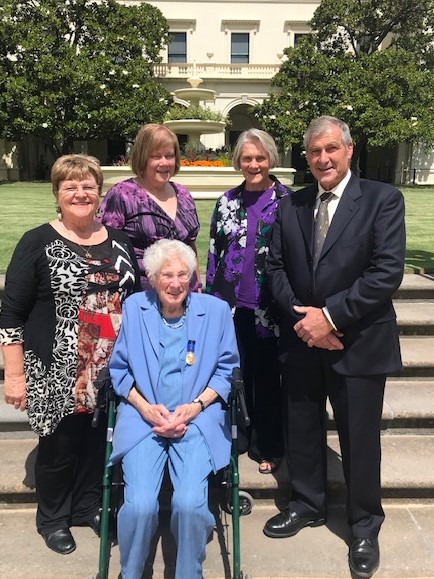
Photo: Eulalie Brewster at her OAM ceremony. Credit: Alison Brewster
In 2020, the great-grandmother was awarded Australia’s highest honour - the Order of Australia medal - for her volunteering work, which also includes work with the local historical society.
‘I was most surprised to be sent an invitation to accept the Order of Australia. I thought it was a scam,’ the down-to-earth nonagenarian said.
To learn more visit https://www.facebook.com/southgippslandconservationsociety/
When Alan Pentland left the city and his TV comedy career behind four years ago with wife Myelene, they knew adventure was on the horizon.
Searching for a treechange, the couple visited an old friend on French Island in Western Port Bay, and almost immediately bought their 75-acre property, nestled between two fringes of the island’s national park.
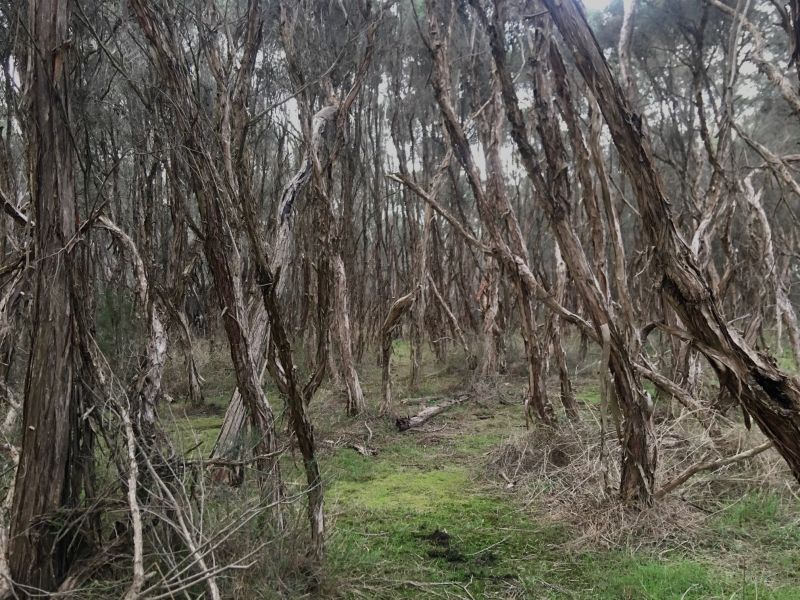
As the Pentlands began life at their new home, they planted a few trees and contemplated a future for their big backyard. While debate raged on TV about environmental destruction, they happened across their big idea.
‘I thought, well, we have a big area, and if we can do anything to help the environment, we certainly are in a position to plant trees,’ Alan said.
The couple began researching local native trees and spoke with fellow French Islanders about what their land may have looked like hundreds of years ago.
‘We thought, wouldn’t it be great to bring both sides of the national park back together. We could create a really fantastic wildlife corridor if we just linked it all back up. So that’s what we decided to do’ Alan said.
They calculated 5000 trees would be needed to fill the void, and in 2019 put a call out on Facebook for volunteers to help raise funds to buy the seedlings, before joining them on French Island for planting. They put in the first 500 plants – a mix of stringybarks, manna gums and swamp gums – and ordered the next 1000 plants for 2020.
‘Then, of course, COVID hits, and the team of volunteers we had lined up on the mainland couldn’t come over anymore, so we had 1000 plants and we said to each other, let’s just do this – and we did.’
With the recent release of near-threatened Eastern Barred Bandicoots on the island, plus a thriving population of potaroos and koalas, the wildlife corridor will help animals access more habitat and resources. The couple remain motivated to keep working toward their target of 5000 trees. They are currently preparing their next 300 for planting, and are among 5000 Victorian landholders proud to be part of DELWP’s Land for Wildlife program.

Now in its 40th year, the program facilitates voluntary agreements with private landholders to manage and restore habitats for wildlife on their property. Since 1981, volunteers have restored or retained 165,000 ha of wildlife habitat – put together, an area roughly the size of Victoria’s Grampians National Park.
Photos: Top shows French Island trees, bottom picture shows Alan Pentland preparing to plant. credit: Alan Pentland
Find out more: https://www.facebook.com/frenchisland5000trees
City laneways and high-rise balconies might not be where you expect to find a team of environmental volunteers.
But a group of dedicated city-dwelling nature lovers is proving you don’t always need wide open spaces to better protect and preserve local wildlife.
Almost 30 volunteers dedicate their time to re-wilding city spaces with plants to attract local birds, insects and wildlife as part of the City of Melbourne’s, Gardens for Wildlife Melbourne program.

They visit city spaces and CBD residents interested in creating wildlife-friendly laneways and balcony gardens. Volunteers then produce reports about native plants that can be re-introduced to the urban gardens to attract wildlife, and help residents create the new wildlife-friendly green spaces.
Rachel Shea joined the program as a volunteer when it began, attending the very first meeting. “I got involved because I really wanted to learn more about native plants and also to just get a little bit more involved in our environment,” Rachel said.
Katherine McPherson, who lives in one of Melbourne’s much-loved laneways, Guildford Lane, has also volunteered since the first meeting. ‘I really wanted to start introducing native plants into the laneway to better support the small birds and creatures, the butterflies and insects that were starting to emerge in the area’, Katherine said.
As well as creating a space for city wildlife to thrive, the community has also benefited from learning more about their environment and having a little slice of nature to enjoy, particularly during COVID-19 lockdowns.
‘I know from speaking to people that live in high-rises that during lockdown, the garden was their haven,’ Katherine said.
‘People walk up the lane and say, this feels like a community and it just brings such joy to know that they are experiencing exactly what we wanted them to experience’, Katherine said. The Department of Environment, Land, Water and Planning is a proud supporter of the initiative between community groups and councils. Now in its third year, the Gardens for Wildlife program spans over 25 municipalities across Victoria.
The Melbourne program is a partnership between City of Melbourne and Westgate Biodiversity: Bili Nursery and Landcare. It has been inspiring Melburnians to make a meaningful contribution to conservation since 2019.
Photo: Rachel Shea, Gardens for Wildlife Volunteer. Credit: Claire Bonieux
To learn more visit https://www.facebook.com/Gardens4WildlifeVic
Thornbury Primary School in Melbourne’s inner north is a proud leader in Indigenous education.
16% of students are Aboriginal or Torres Strait Islander and the school offers a leading Indigenous language and culture program, which includes students learning the local Woi Wurrung language of the Wurundjeri people.

When parent and school councillor Renee Wierzbicki found out about a Junior Landcare grant program, the school proposed an exciting project to complement its language and culture program.
It would create a Native Food Garden, featuring local Indigenous and native plants. There would be edible plants for students to cook with, grasses and fibre plants for them to weave with and a little sanctuary for local wildlife to enjoy. The school was awarded the $5,000 grant.
In 2019, Renee, a horticulturist at the Royal Botanic Gardens Victoria, volunteered her time, technical skill and expertise to help make the dream come to life. Renee worked alongside the school’s language and culture teacher Aunty Terri-Lee Fitzpatrick and Thornbury PS Garden Educator Aviva Reed on plant selection. The school had four working bees with around 40 parents, carers and volunteers at each creating the garden.
‘It was truly amazing to see all of these parents volunteering their time – some with completely no experience in this space, putting their hands up and asking what they could do to help,’ Renee said.
The garden was launched at a whole-school celebration with a special smoking ceremony and Welcome to Country. It began to grow and take shape.
‘And then it’s 2020 and COVID hits,’ Renee said. ‘A dedicated team of volunteers came together and said we’ve got to keep this going, even in lockdown’. They rostered themselves for watering duties and light garden maintenance and set about keeping the Native Food Garden alive.
‘We did lose a few plants, but the overwhelming majority survived and we were just so pleased for everyone involved, but especially for the kids,’ Renee said.
Fast-forward to May 2021 and the volunteers continue to help maintain the garden. They are also back selling Indigenous plants to the school community to help fundraise for the garden.
Photo above: Sam, Saul and Kim in the Thornbury Primary Native Food Garden. Credit: Renee Wierzbicki.
Photo below: Thornbury Primary School Garden Educator Aviva Reed (left) with Language and Cultural Teacher Terri-Lee Fitzpatrick (right). Credit: Renee Wierzbicki.

When COVID-19 hit, the dedicated team at BirdLife Australia discovered housebound Victorians had more on their minds than Netflix and Zoom meetings.

‘All of a sudden, we started getting all of this traffic to our Birds in Backyards survey webpage where people can record their observations of the birds in their own backyards,’ BirdLife Australia Volunteer and Network Engagement Officer James Matcott said.
‘Usually we’d have around 500 people volunteering their time to do the surveys, and all of a sudden we had 7,000 people hit our website in the peak of Victoria’s 2020 lockdown and thousands doing the survey.’
BirdLife Australia uses the survey data submitted by volunteers to monitor changes in the distribution and abundance of either whole groups or individual birds, and to encourage residents to connect to their local wildlife.
James said that backyard birdwatching became such a popular lockdown activity that BirdLife Australia’s Birds in Backyards Facebook page grew by tens of thousands, peaking at 36,000 backyard bird volunteers across Australia.
‘At peak lockdown, there was certainly a lot more backyard birding volunteering going on,’ James said of the time he and his team worked relentlessly to support the 800% increase in online interest.
Among the most prolific lockdown birdwatchers were thousands of Melbourne CBD residents who created a spike in followers to the Melbourne CBD Peregrine Falcons Facebook page.
The 14,000-strong group would submit photos of the falcons and their chicks hatching from their Collins St home, building up such a large online cult following they began livestreaming to thousands on YouTube.
Photo above: Aussie Backyard Bird Count, credit: James Matcott. Photo below: Jane Rusden , Birdlife Castlemaine credit: Jane Rusden

Back in Campbell’s Creek near Castlemaine, long-standing Birds in Backyards volunteer Jane Rusden, 53, continued volunteering throughout COVID-19 as she has done since 1992.
”I’m deeply passionate about the environment and I’m pleased to be doing my bit to contribute by volunteering,” Jane said.
Find out more: https://www.birdsinbackyards.net/
Whale watching has been a happy pastime along Victoria’s coast for decades. But today, it’s not just binoculars that keen whale watchers take along to the shore.
Today, the many volunteers involved in the Department of Environment, Land, Water and Planning’s (DELWP) Southern Right Whale Research Project are also armed with smartphones and digital cameras.
And when volunteers do get a sighting, they take out their phones and cameras and take photos. Images that capture skin growths on the face of Southern Right Whales help us tell individual whales apart. Photos that are uploaded to the WhaleFace, an online portal, help researcher to learn more about these amazing animals and track their life histories.
While Southern Right Whales can be spotted anywhere along the Victorian coast, Logans Beach at Warrnambool is particularly popular among whale watchers. It's the only location in south-east Australia where female Southern Right Whales regularly return to give birth.
In Warrnambool, around 20 dedicated citizen scientists gather each year- mostly Deakin University students and some locals –giving time between May to October to scan the ocean at Logans Beach for Southern Right Whales. Stationed at the whale nursery, these volunteers help us to understand more about the 15 or so breeding female whales as they come to calve.

‘Long Coaming’ is one of the frequently visiting female Southern Right Whales that two dedicated volunteers have been tracking in different ways. Chris Farrell has been photographing her from a light plane for WhaleFace. Peter Read from Warrnambool Whale Watch, has been recording daily sightings of Long Coaming from the land – where he spends 6 hours per day during whale season.
Chris is a wildlife photographer who has been volunteering for DELWP’s Southern Right Whale Research Project for the past 6 years. ‘I have seen and learned amazing patterns about whales. They are incredible creatures and also very playful,’ he said.
Peter, a volunteer of 10 years, said he finds such joy in playing his part in understanding the changes among this much-loved endangered whale population over time. ‘Whales are impressive animals and it is so rewarding to be able to identify them coming back to the shore from year to year,’ he said.

In addition to the 20 Logans Beach volunteers, there are a further 154 volunteers across Victoria signed up to the WhaleFace portal contributing their whale sightings along Victoria’s coastline. Anyone can join the WhaleFace community to share their sightings, view the contributors’ gallery and receive updates via the newsletter.
photo credits: Chris Farrell.
To find out more about WhaleFace, visit:https://www.swifft.net.au/srwsmp/
WhaleFace was formally known as the ‘SWIFFT Southern Right Whale photo identification project’
In the fast-moving world of demands upon our time, one environmental group is keeping volunteering achievable and enjoyable for more than 5,000 Victorians.
Slow and steady always wins the race at BeachPatrol and its inland offshoot, Love Our Street.
Just once a month, Victorians pull on their gloves to join one of 30 BeachPatrol or Love Our Street groups to spend an hour or so simply picking up rubbish. BeachPatrol groups comb the coastline collecting litter, and Love Our Street hit their local shopping strips and streets to do the same.
For what seems to be a small commitment, the collective results are enormous, with bags of rubbish, including many dangerous plastics fished out of our beaches and streets each time a BeachPatrol or Love Our Street team is in action.

Even during the COVID-19 lockdowns, the groups thought outside the box to continue keeping their much-loved local public spaces clean.
Love Our Street Werribee founder Lisa Field was among those behind Love Our Street’s lockdown micro-concept, Love Our Patch.
‘We created webinars for local communities to share their ideas on litter collection and cleaning public spaces during the lockdown, and to encourage people to pick-up litter during their 2 hours of exercise within 5kms, very close to home,’ Lisa said.

Over in Port Melbourne, long-term BeachPatrol and Love Our Street volunteers Ramona Headifen and Pam Grills enjoy the community aspect of the groups, and how easy it is for anyone - including busy people - to get involved.
‘People who contact us and want to volunteer, most of the time, already pick-up rubbish,’ Ramona said. ‘They want to be part of a community and to meet other like-minded people who want to fight for the environment.’
Pam, a local primary school teacher, said it’s important to her to give back to the planet – even in a small way.
‘I also teach sustainability at school and want to be a great role model and an advocate for positive environmental change,’ Pam said.
Photo top: 3182 St Kilda Beach Patrol; credit Ramona Headifen.
Photo bottom:Pam Grill, Beach Patrol and Love our Street 3207 volunteer Port Melbourne; credit Pam Grills
To find out more, visit: https://www.beachpatrol.com.au/
In the wake of Mallacoota’s 2020 summer bushfire crisis, a group of local youths came together to lobby for a local support space.

The Sanctuary Mallacoota Youth Group was quickly formed, providing a safe haven for Mallacoota’s young people to be together, support each other and develop their skills as they recover from the fire.
In the months following the disaster, Mallacoota’s youth used the space to study, play music, make art, playgames, organise programs and events and run workshops. Many discovered their shared passion for protecting their local coastal environment.
While the bushfire-ravaged forests are still too dangerous for local young people to assist with regeneration volunteering efforts, some among the group noticed local coastal areas that could be improved.
Paris Brooke’s daughter Matisse Turner, 10, was among those to create the Sanctuary’s Wilderness Coast Project. On the last Saturday of each month, Matisse and around 30 other kids and teens turn out around Bastion Beach to help restore the coastline, which was falling prey to invasive weeds.
They applied for a Coastcare Victoria Community Grant, in collaboration with Friends of Mallacoota, and in late 2020 were awarded a grant of up to $30,000 to assist with their land and coast management activities.
The group now weed, plant new trees, audit litter and do general conservation work around local beaches.
‘It is a fun way for the kids to spend time caring and learning about Landcare and Coastcare as well as building friendship within the community,’ Paris said.
Matisse said she was enjoying volunteering for the environment.
 ‘
‘
Beach weeding is so easy and relaxing. I could spend hours doing this on the beach especially knowing that I’m doing good for the environment,’ she said.
Photo - top : Mallacoota volunteers weeding on Bastion Beach. credit: Paris Brooke. Photo - bottom: Matisse Turner
Find out more: https://www.facebook.com/SanctuaryMYG/
National Volunteer Week 18 - 24 May 2020
Victoria's environmental volunteers span all ages, cultures, and work across a range of groups and organisations. From community nurseries to marine life, frogs to fish ear bones, volunteers are doing great work in and for our environment.
To celebrate and promote the work being done by our environmental volunteers during National Volunteer Week, we have compiled a selection of fabulous stories about volunteering groups and projects. Click on the drop-downs below to read their inspiring stories:
Off the coast of Cape Conran in East Gippsland lies Beware Reef Marine Sanctuary, a 220-hectare wonderland of marine life and habitat.
Until recently, volunteers from the Friends of Beware Reef environmental group could often be found diving in the sanctuary, conducting underwater surveys of marine life.
"We usually aim to dive on a weekly basis, but this has been made quite challenging in 2020 due to the bushfires, as well as coronavirus,” said Don Love, President of Friends of Beware Reef.
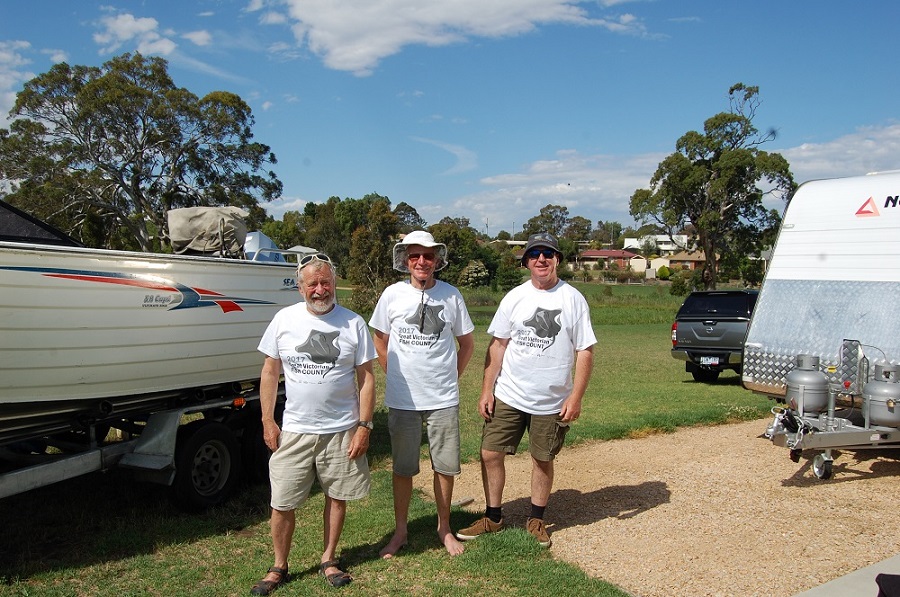
Volunteer members of Friends of Beware Reef.
Bushfires over the summer also prevented the group from attending Summer by the Sea, where they have been participants for more decade, sharing their unique underwater experiences with locals and visitors.
Formed by a group of passionate divers over 15 years ago, this group of 10 active members has built a reputation as a reliable and prolific contributor to the environmental and scientific community.
The group works closely with Parks Victoria, the land manager of the marine sanctuary. They have also freely shared scientific knowledge with Coastcare Victoria, Museum Victoria, and the University of Tasmania through their Reef Life Survey program.
A Coastcare Victoria grant the group received last year has been used to buy a new waterproof camera. It has improved the quality of their photographs and videos which are used to identify species and shared with research institutions.
“We are lucky to have a member that can put videos together with ease. It is amazing what macro photography can highlight - especially with the marine invertebrates,” said Don.
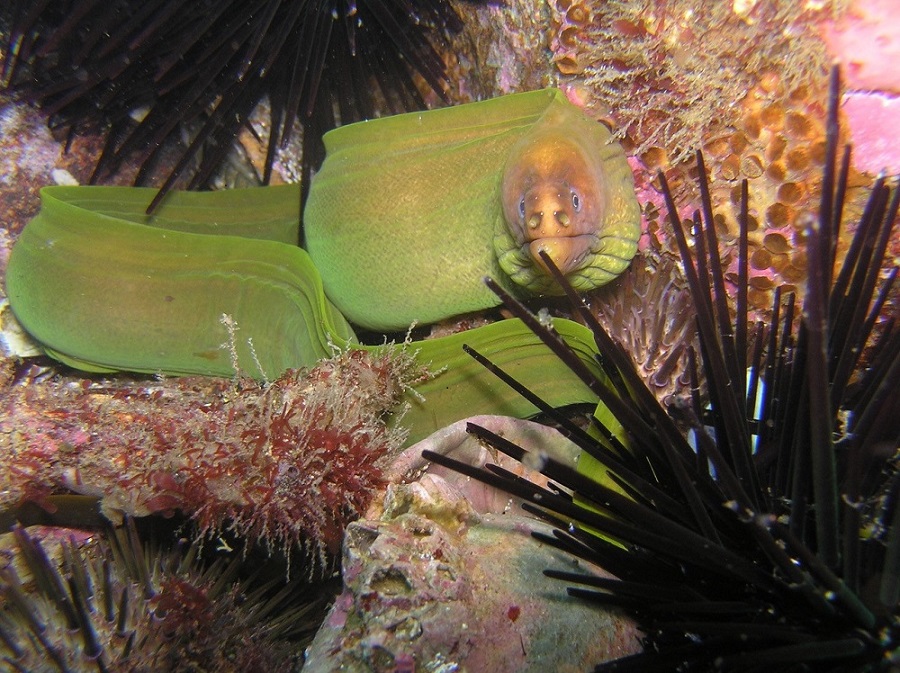
Green Moray Eel - Gymnothorax prasinus at Beware Reef.
The group has been heavily involved in eradicating invasive species in Beware Reef and Gippsland Lakes. In the past year they successfully removed 13 North Pacific Sea Stars from Gippsland Lakes.
They were also part of a trial with Parks Victoria to reduce Long Spine Sea Urchins that wreaked havoc on the reef. “We found that it took at least two years for the larger kelp species to return to the damaged reef areas,” explained Don.
Not all their work is underwater however – community education is a key facet of their activities.
“Our ethos has been to educate both the locals, tourists and the wider public about what there is to see under the waters both off our coast and inland within the Gippsland Lakes,” Don said.
“We have taken much pleasure in educating the public from children through to the elderly within our community,” he added.
Whilst coronavirus (COVID-19) restrictions have meant staying home, it has given this close-knit band of divers a chance to reflect on their achievements.
“The great reward for us is to see the database we have accumulated both photographically and scientifically, which shows trends in marine life we have observed as a result of our data collection over a long period of time,” said Don.
The move from outdoor activities to the online world has also given Don the opportunity to reach people virtually, through Parks Victoria and Coastcare Victoria’s inaugural Winter by the Sea online activities and events program.
He will be sharing his knowledge and enthusiasm with a live online presentation about the marine life of the Gippsland Lakes this August.
You can find Friends of Beware Reef on Facebook
Recreational fishers have become citizen scientists as part of a study of Victoria’s rivers and creeks.
The Angler Citizen Science project was led by the Arthur Rylah Institute for Environmental Research (ARI). It used a range of methods to monitor fish in northern Victorian rivers, including the collection and analysis of fish ear bones - called otoliths.
“Otoliths play a role in fish balance and hearing. Amazingly, looking at an otolith under a microscope can tell us the story of a fish’s life – its age, growth, which rivers it has been in, and even if it is a stocked fish or a naturally bred fish,” explained Dr Zeb Tonkin, Senior Scientist at ARI.
“Working out its age is a bit like counting the growth rings on a tree stump. For a little bone in a fish, we can get an amazing amount of information,” he said.
This information about fish movement, breeding and survival can provide insights into the effectiveness of ‘water for the environment.’ This is water that is set aside in dams and then released through regulators to support rivers and wetlands and their plants and animals.
ARI scientists had been collecting otoliths from Golden Perch and Murray Cod as part of their routine monitoring for their Victorian Environmental Flows Monitoring and Assessment Program (VEFMAP).
They saw an opportunity to increase the sample size by working alongside anglers who were catching these species to keep and eat.
“We recognised that anglers were out there catching fish themselves in our northern Victorian rivers, and that we could get some great extra information from the fish they were keeping,” Zeb said.
“The more otoliths we have, the better our understanding will be of how fish respond to water for the environment,” he explained.
In early 2018, angling clubs in northern Victoria were contacted to gauge their interest in taking part. ARI also promoted the project through presentations at angling club meetings, regional events and forums, and other collaborators.
A video was developed outlining how to extract an otolith and a training day held near Elmore in late 2018.
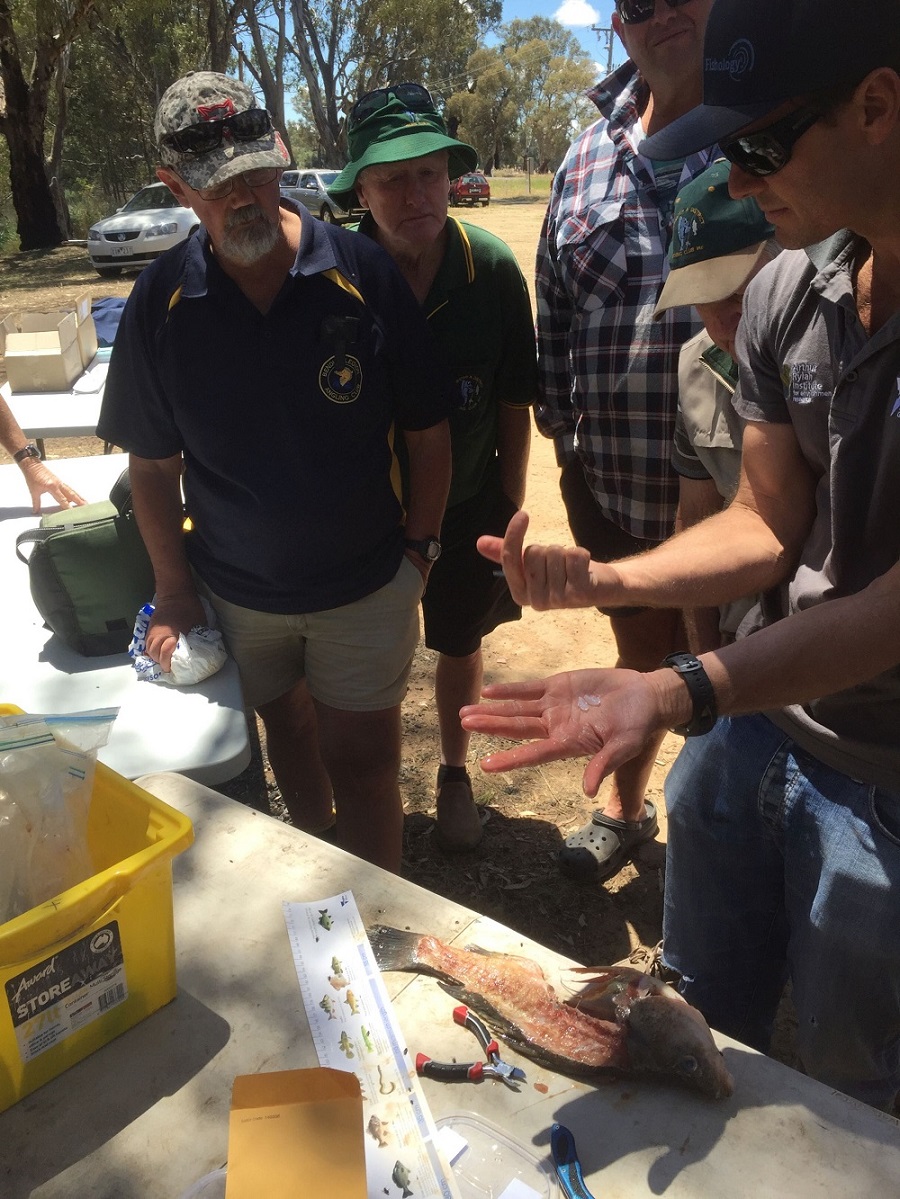
Zeb Tonkin, ARI Scientist, shows angler scientists how to extract a Golden Perch earbone.
Angler Scientist Kits were sent to participants, which provided background information, instructions and tools to extract and record the otolith details. Those who did not want to remove the otoliths themselves could freeze the fish instead.
Over the course of the project up to June 2019, 84 Golden Perch and 25 Murray Cod otoliths were collected from 12 rivers, creeks and lakes in northern Victoria by angler volunteers.
Once the samples were analysed, participants were provided with fish profiles for each of their fish which outlined the fish’s age, where it was born, and if it was captured in a river, where it had moved from.
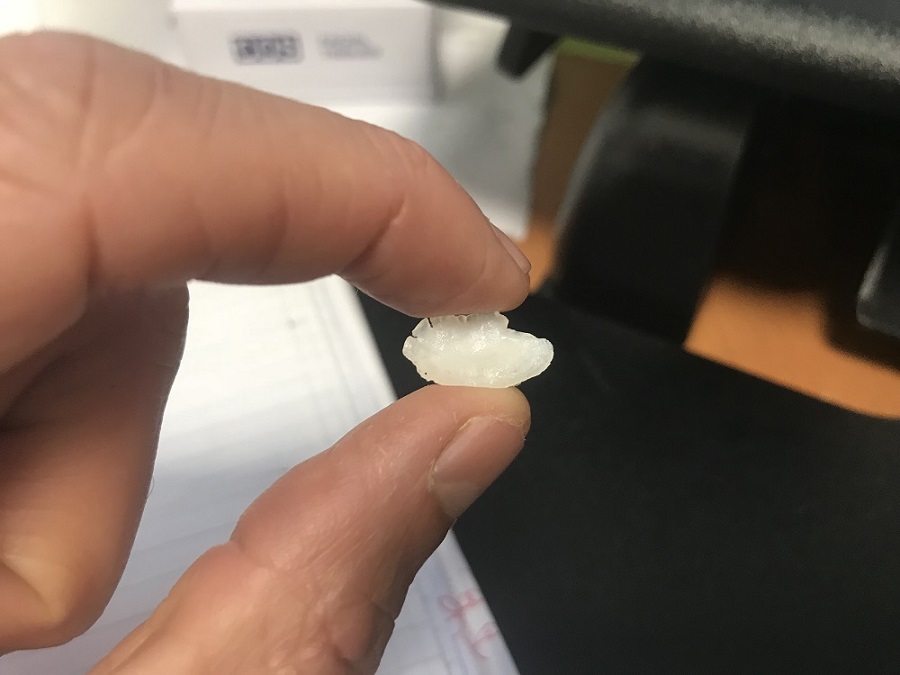
The results showed that Golden Perch can move far from their birthplace, with three born in the lower Darling/Murray River junction caught near Cobram East over 1,000 kilometres away. This has been found in other monitoring studies, showing the need to coordinate water for the environment at large spatial scales.
For the Campaspe River, evidence of a natural increase in Murray Cod numbers and strong growth of stocked Golden Perch indicate that water for the environment is working in this river.
“During this project we hoped to not only gain additional otolith samples, but also provide a meaningful and satisfying experience for the volunteers. It enabled scientists and anglers to connect and share information,” said Pam Clunie from ARI.
“We aimed to increase angler and broader community awareness of the benefits of water for the environment and VEFMAP,” she added.
Scientists and anglers working together has also provided an opportunity to build strong relationships, leading to an improved understanding of each other’s perspectives and interests.
For more information visit the Arthur Rylah Institute for Environmental Research.
This project was a collaboration between the Department of Environment, Land, Water and Planning, angling clubs and individual anglers, North Central Catchment Management Authority, Goulburn Broken Catchment Management Authority, and Victorian Fisheries Authority.
Curious Victorians have been recording the sounds of frogs in their local area for citizen science project The Frogs Are Calling You.
Recordings are made on smartphones using the Australian Museum’s FrogID app. With the data obtained through FrogID, researchers can identify where frogs are thriving and where they aren’t.
By matching frog calls to weather and habitat, scientists are learning more about how different species are responding to a changing environment.
This data can also help scientists understand the effects of adding water to wetlands to help maintain and improve the health of native plants and animals.
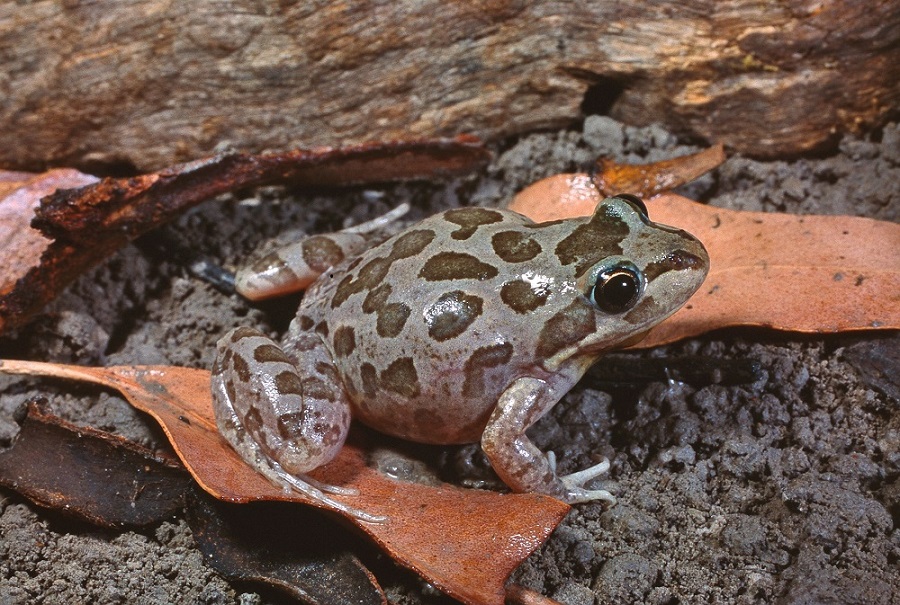 Spotted Marsh Frog. Photo credit: Geoff Heard
Spotted Marsh Frog. Photo credit: Geoff Heard
Researchers monitor this process, known as ‘water for the environment’, so that the right amount of water is delivered in the right places at the right time.
Scientists from the Arthur Rylah Institute for Environmental Research (ARI) are doing this as part of their Wetland Monitoring and Assessment Program (WetMAP) which monitors frogs, fish, vegetation and birds.
WetMAP scientists Dr Geoff Brown and Elaine Bayes have been monitoring frogs since 2018.
“We started monitoring to understand if environmental watering makes a difference to frog diversity and abundance. The ecology of wetlands is very complex and understanding how and when to water them is challenging,” she said.
During the day they look at habitat structure and water quality, and at night, they listen and actively search for frogs, tadpoles and eggs. These surveys are happening at 29 wetlands across northern Victoria.
Scientists can’t cover all the locations they would like to, and that’s where The Frogs Are Calling You comes in.
“Citizen scientists have access to lots of places that the WetMAP scientists can't reach. Wetlands on private properties are huge sources of information we wouldn't otherwise have,” explained Dr Lynette Plenderleith, project leader of The Frogs Are Calling You and President of Frogs Victoria.
“Some wetlands are close to the citizen scientist's home and they can visit more often and at different times to the frequencies professional scientists could manage,” she said.
“This is even more pronounced with everyone staying at home recently, but many citizen scientists are still recording as the wetlands they monitor are close to their homes.”
One volunteer who recorded frog calls on his land is Brendan O’Brien from Benalla in the north-eastern region of Victoria. Brendan was inspired to join The Frogs Are Calling You to learn about frogs living in the dam on his property.
“The scientists send you an email after each recording you submit through the FrogID app, confirming the species identified,” said Brendan.
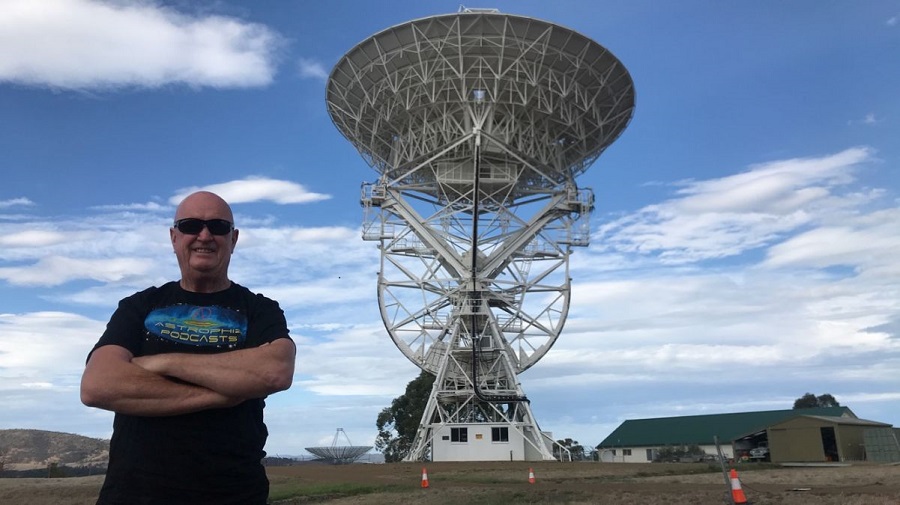
Brendan O’Brien, volunteer
Victoria’s wetlands are home to some 40 frog species. Brendan now knows which seven of these species live in his dam, their calls, life and breeding cycles, and habits. He plans to continue contributing to the project.
“I’ve learnt that making small recordings throughout the year is important to build up the research knowledge of our hoppy little friends,” he said.
“I’ve also learnt a lot about other fabulous Australian frogs, and our need to protect our threatened wetlands and waterways.”
Up to May this year, the project has received 415 records from citizen scientists. The most recorded frog is the Spotted Marsh Frog, whose call sounds like a high-pitched cluck.
The second most recorded frog is the Pobblebonk followed by the Common Eastern Froglet and Emerald Spotted Tree Frog.
If you want to join in and record frog calls on your property you can find out more at frogscalling.org.
The Frogs Are Calling You is a collaboration between The Department of Environment, Land, Water and Planning, Frogs Victoria, the University of Melbourne, the Australian Museum, Goulburn Broken Catchment Management Authority and North Central Catchment Management Authority.
Every Friday in the small town of Bass, just over 100 kilometres south-east of Melbourne, local volunteers meet at the community nursery at Bass Recreation Reserve.
Here, they grow native plants for revegetation within the Gippsland Plains and Strzelecki Ranges, mostly for farmlands.
Robbie Gray, Ecosystem Services Manager at Bass Coast Landcare Network decided to start a community nursery four years ago. He realised the network needed somewhere to store seedlings until planting sites were ready and wanted to gain more control over their supply of plants.
At the time, he had been running a series of plant identification, seed collection and plant propagation workshops with a regular group of volunteers. Robbie pitched the idea of forming a nursery group, and with an enthusiastic response from the volunteers, his idea came to life.
The nursery currently has around 10 regular volunteers, who joined for a variety of reasons.
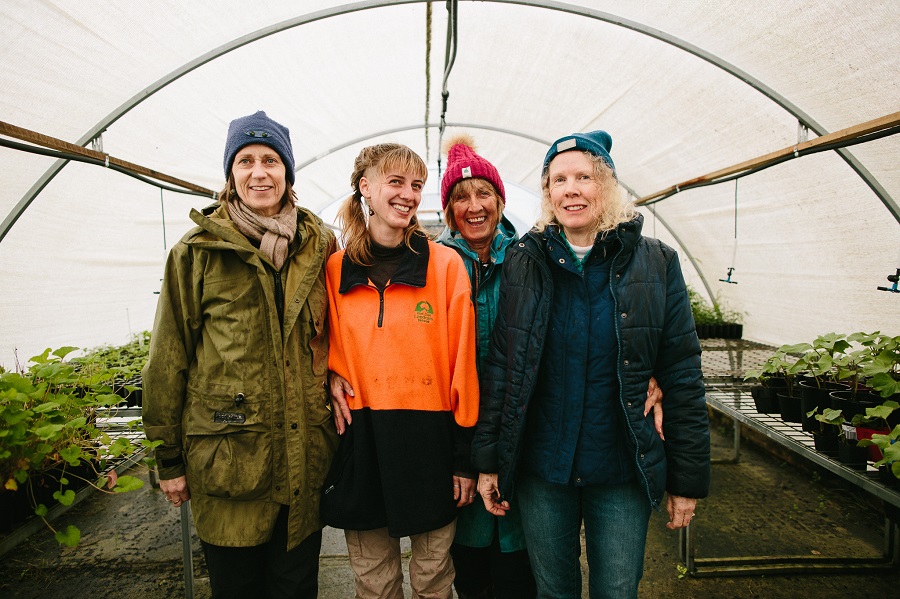
Linda Nicholls (volunteer), Stevie Wynen (staff), Anna Spiden (volunteer), Liz Bernal (volunteer). Photo credit: Andrew Northover, West Gippsland Catchment Management Authority.
“I felt that it was appropriate for me to give back to Landcare as they have been helping us plant out our property,” said Anna Spiden. “I find it very rewarding to see plants grow from seed and then to see them go out to become a part of greening our bare hills,” she added.
Fellow volunteer Liz Bernal also enjoys seeing how her work contributes to the local landscape.
“Seeing land where vegetation that we, as a nursery, have grown, is very humbling. Knowing I am part of improving the environment and adding value to the land is so important to me. Also knowing that the trees will hopefully be there for generations to come,” she said.
The nursery produces 42,000 plants a year and locals can have plants grown to order for a minimal price.
Over the years their offering has developed to meet the needs of the land, said volunteer Liz Nicholls.
“We are growing ground cover plants (commonly found in the Strzelecki Ranges) that are equally important when regenerating the land - not just the middle and top storey plants. A whole variety of insects will now be attracted to this new habitat that will evolve as they grow on farmers’ land,” she explained.
Roger MacRaild, Landcare Facilitator at Moorabool Landcare Network, found himself in a similar situation to Robbie when he was given a few thousand unallocated plants in late 2018.
Roger housed the plants on the site of an old Landcare shed in Rowsley, 50 kilometres west of Melbourne in the Moorabool shire. He then formed a committee to expand the nursery focussing on unusual native and indigenous species to revegetate local private and public land.
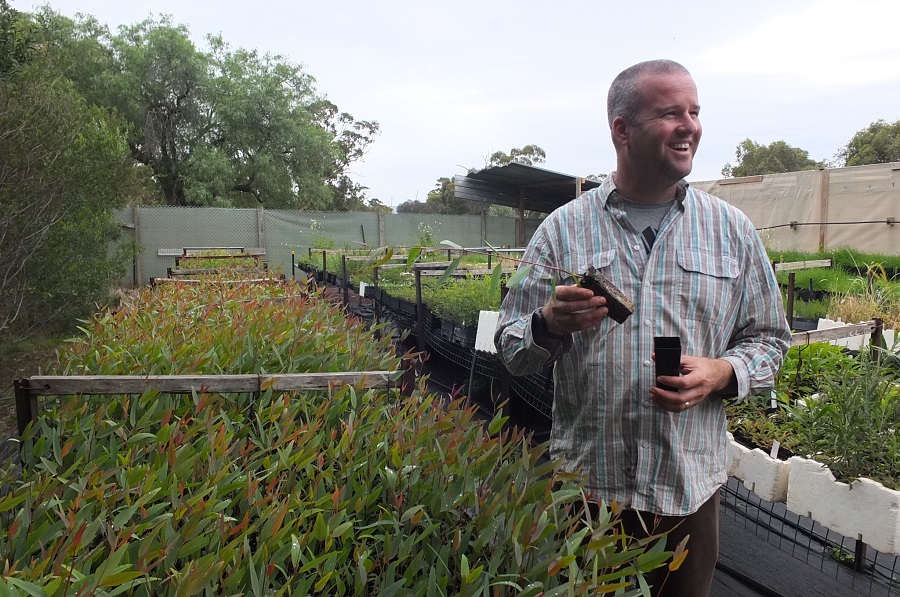
Roger MacRaild, Landcare Facilitator at Moorabool Landcare Network
The nursery started to take shape in 2019 when Roger secured a grant from Port Phillip and Westernport Catchment Management Authority.
This funded staff from Wathaurung Aboriginal Corporation to help expand the facilities. They also assisted with propagating plants and in turn developed their plant identification skills.
With the further help of a state-government funded grant through Moorabool Shire Council, Roger upgraded the shed and surrounds into a small-scale commercial nursery.
Roger says the dozen core volunteers at the nursery are essential to its success, which generated 25,000 plants over the past year.
“We have such a wealth of knowledge and ability amongst our regulars. They each contribute something slightly different,” he said.
Both Roger and Robbie appreciate what they have gained from working with environmental volunteers.
“I think the most significant thing I've learned is the value of having a disciplined and generous spirit. I've learnt so many little things that add up to an awful lot,” said Roger.
“They have opened my eyes to the amount of time and energy volunteers give to the community,” Robbie said. “Their continual involvement is impressive - that they have committed to the nursery and they care.”
To find out more about visit Bass Coast Landcare Network and Moorabool Landcare Network
The picturesque Bellarine Peninsula south-west of Melbourne is the home of Bellarine Catchment Network (BCN), a group made up of 30 representatives from catchment and coastal organisations.
Matt Crawley, BCN Program Manager, understands the importance of bringing together complementary organisations to integrate their work to protect and manage the local environment.
“The network has been around for 23 years and over that time non-government organisations, community volunteer groups, and different land managers such as councils, foreshore committees and committees of management have worked together through BCN,” he said.
Their common purpose is to “deliver more environmental outcomes and more community education,” he explained. “This integrated model benefits the environment and the communities on the Bellarine Peninsula.”
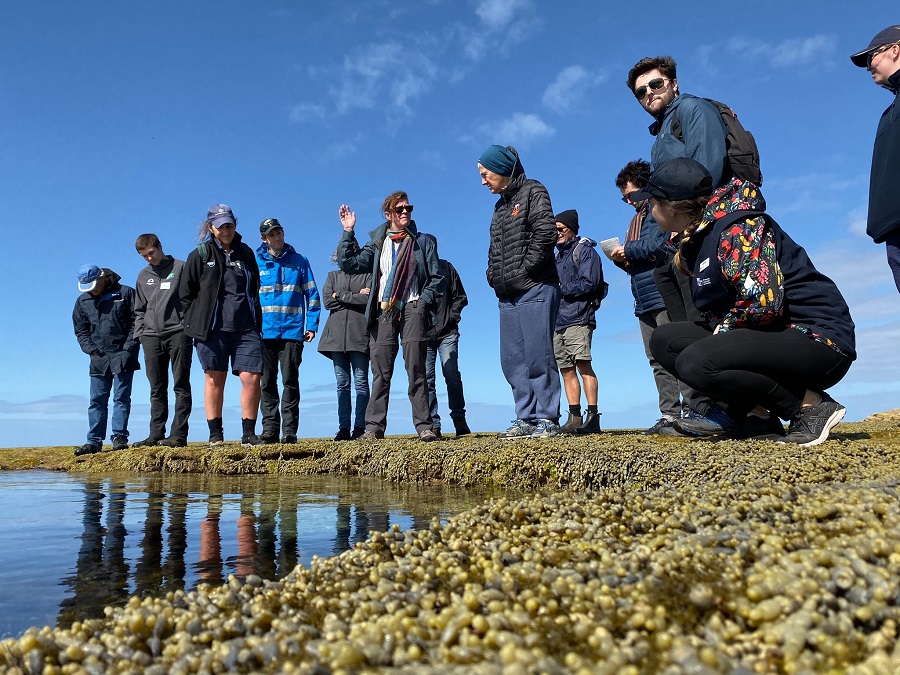
With the help of a Community Skills Development Grant, BCN organised an activity and training day for its members in October last year.
Delivered by the Marine and Freshwater Discovery Centre (MFDC), the main purpose of the day was to ‘train the trainer.’ Participants learnt how to engage and educate their own student or community groups.
Attendees visited Rocky Shore where they learnt about marine interpretation, animal and plant identification, geology, history and cultural heritage.
A mudflat meander followed. They looked at the ecosystems that make up the substrate of Swan Bay. The day concluded with a tour of the MFDC in Queenscliff.
“We saw an opportunity to share our skills with the different people who deliver education at schools, community groups, and festivals and events during the summer,” Matt said.
Collectively, staff and volunteers from BCN member groups speak to thousands of people each year.
“We wanted to give everyone more skills in their toolbox and therefore give the community more understanding and appreciation, which leads to better protection of the environment,” he added.
Sixteen community groups, organisations, land managers and councils were represented on the day and many of the 20 participants were from environmental volunteer groups.
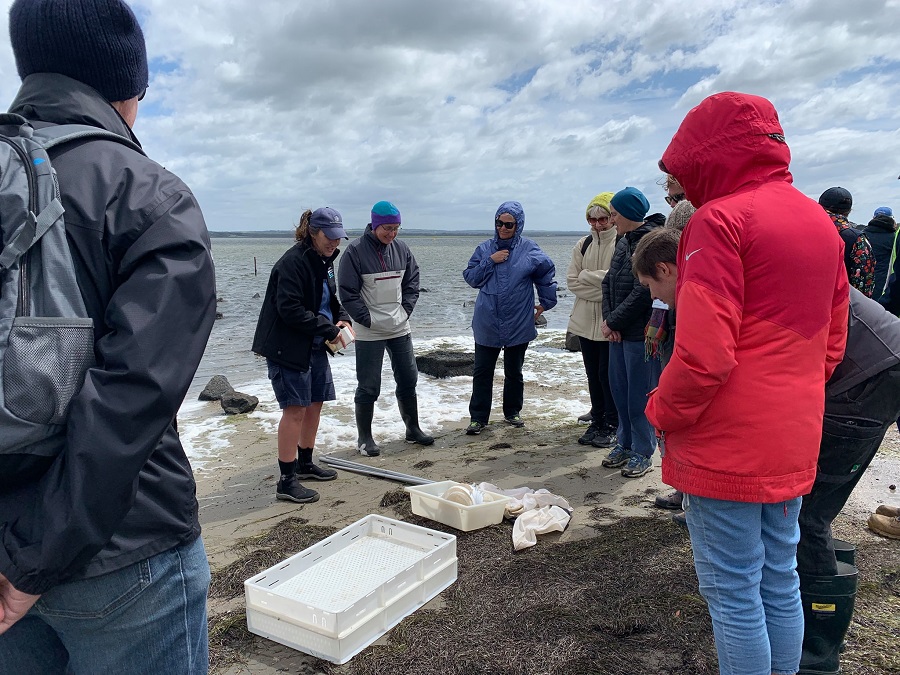
“We participate in school education days and we appreciate getting our volunteers - most of whom have no professional background in the environment, marine or otherwise - to attend training like this,” said Margot Busch from Ocean Grove Coastcare.
“It boosts their confidence in delivering education sessions,” she added.
“The training made me more aware of some of the threats to the marine environment,” said Mel Rogers, Chair of Bellarine Bayside and member of Friends of Edwards Point. “It is so much better to actually see things in their natural habitat and have someone knowledgeable explain it.”
Matt said the volunteer groups who attended the training day “have used the knowledge they gained to better deliver messages around coastal stewardship - how you can appreciate it and have a positive effect on the environment rather than a negative impact.”
To find out more visit Bellarine Catchment Network.
The Friends of Dandenong Valley Parklands are an active group who work within Shepherds Bush, Jells Park, Bushy Park Wetlands and Koomba Park.
The group have around 30 regular members who contribute to a range of different regular monthly and adhoc activities such as the propagation of plants, Waterwatch, weed control, birdwatch walks, managing and maintaining an indigenous garden, history walks, planting, engaging with other volunteer and corporate groups and National Tree Day.
In their nursery they have managed to propagate and maintain 8000 plants since last year to contribute to the Living Links and Bushy Park Wetlands Revegetation projects and, National Tree Day.
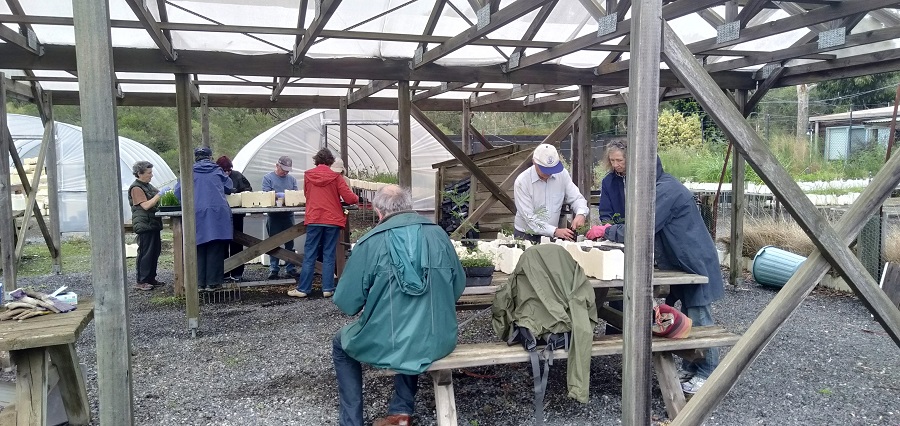
The Living Links Project is a 3 year (now in its final year) Parks Victoria project funded by the CMA. It is a collaborate project which aims to provide a web of green and to help people connect with nature in an urban environment.
Throughout the project the Friends of Dandenong Valley Parklands have assisted immensely by propagating over 5000 plants each year in their nursery for the project, helping PV staff organise and deliver numerous planting days and assisting with follow up maintenance at some of the sites.
Throughout this month and next, the Friends of Dandenong Valley Parklands were ready for a number of planting days with volunteers, other Friends Groups (external to PV) and corporate groups to help plant the last 4000 plants, infilling areas of established sites from previous years and finalising the project. However, with COVID-19 present, the volunteers are disappointed they will be unable to put these plants in the ground. Parks Victoria staff will endeavour to keep up the FODVP’s good work and plant as many as possible!
Each year FODVP organise, coordinate and deliver National Tree Day with the help of PV staff for Dandenong Valley Parklands. The event has been extremely successful over the past few years.
Last year approximately 150 volunteers provided a helping hand which resulted in over 2500 plants being put in the ground in koomba Park. This year National Tree Day will be held by the FODVP and PV in Bushy Park Wetlands. We are hopeful that this event will be able to proceed in August as currently planned.

The group were successful in obtaining a Victorian Landcare Grant, provided through the Port Phillip & Westernport Catchment Management Authority of $18,440.
The project aims to restore the Dandenong Creek corridor which is an important habitat for many native species, particularly birds. Historically, it has been subject to agricultural grazing and now is under threat from increased urbanisation resulting in large weed infestations and river bank destabilisation. The group have engaged with contractors to tackle the weed issues in Bushy Park wetlands and have propagated 4,000 plants in their nursery with the anticipation to have these in the ground this winter. A collaborative approach with corporate groups, other volunteers, Parks Victoria staff and members of the public will hopefully see this goal achieved. However, in the current situation of COVID-19 there is a plan B if these events cannot go ahead to ensure these plants go into the ground.
A special mention to David Lumb, the president of the FoDVP who volunteers his time not only undertaking the regular activities, tending to the plants in the nursery on a regular basis but also spends a lot of time behind the scenes writing grant applications, coordinating the group’s activities and assisting Parks Victoria staff.
For more information, please see their Facebook page.
Celebrating our Environmental Volunteers - National Volunteer Week 20 - 26 May 2019
Victoria's environmental volunteers span all ages, cultures, and work across a range of groups and organisations.
During National Volunteer Week 20-26 May 2019, we celebrated Victoria’s environmental volunteers; sharing the stories of a few to help encourage others to get involved. Click on the drop-downs below to read their inspiring stories:
500kgs of rubbish in under a year: ‘Plogging’ is all part of Karin’s running training
Trail runner Karin Traeger is a frequent guest of Melbourne’s parks as she clocks up the k’s training for her endurance events.
But during one 2018 training run in Kew’s Studley Park, the Melbourne University Master of Environment student was struck with a sudden thought.
‘When you’re an athlete training for an event, you often become so focused that you don’t really see too much of what’s around you,’ she said.
‘But I suddenly noticed that there really was a lot of rubbish everywhere that I was running, and I knew then that I wanted to do something about it.’
Karin began picking up rubbish during her runs, and shared this news with her friends and family – who quickly started to join her. Later, with the help of her friend Debbie Clemens, they established this initiative as a social enterprise to help raise environmental awareness around litter prevention.
Fast forward less than a year to 2019, and Karin and the ‘Plastic Runner’ team have staged 20 events across Victoria, collecting around 500 kg of rubbish.
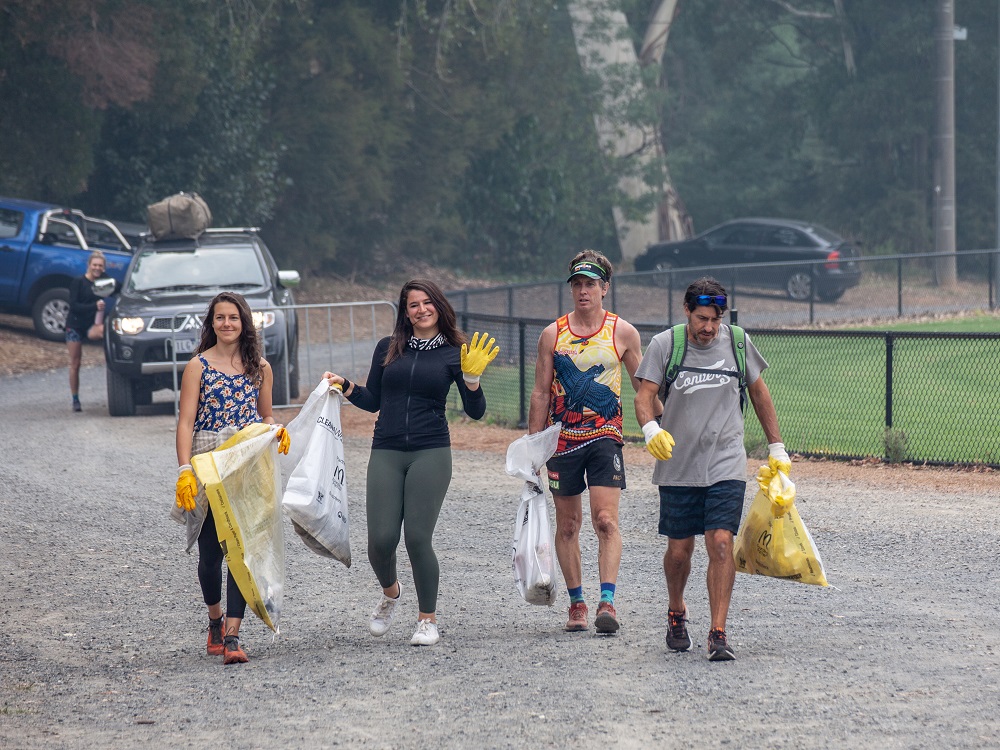
These plastic jogging events have become known as ‘plogging’ and usually range from between 40-90 minutes, attracting up to 40 participants per event.
Karin says environmental volunteering gives her a sense of satisfaction, knowing she’s putting together the things she loves – running and the environment - for a better future.
‘Volunteering for a cause like the environment is to put passion into action, helping selflessly an area where you are passionate about,’ Karin said.
‘Additionally, volunteering can create a community, making it easier when things get challenging, creating new friendships, and encouraging others to be part of a bigger movement. Without our amazing volunteers we wouldn’t be able to keep generating this space and positive impact.’
Find out more about Karin and The Plastic Runner: https://theplasticrunner.com/
School student encourages Melbourne’s Chinese community to participate in environmental volunteering; meets Jane Goodall
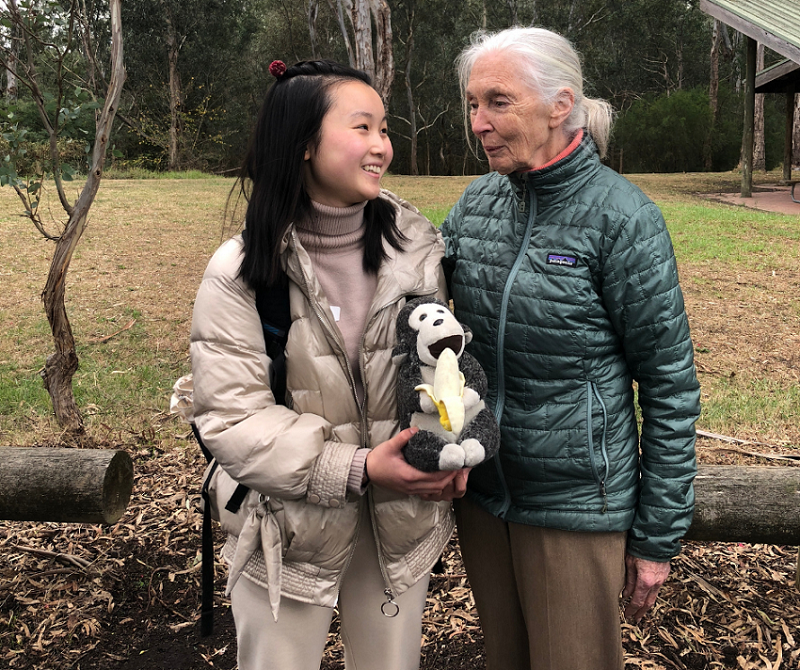
When 16-year-old Chenxin Tu left China’s rural southeast for suburban Melbourne nine years ago, she was adamant not to lose her connection with nature.
The Year 11 student at The Mac.Robertson Girls’ High School grew up in a small village in China’s most forested and mountainous region. She began by marking each of her birthdays in Australia by planting trees since 2017.
‘My birthday is near National Tree Day, so I started inviting friends along to plant trees with me and it evolved from there,’ Chenxin said.
When Chenxin, from Watsonia, began high school in South Melbourne, she quickly learned about the Port Phillip EcoCentre in St Kilda and registered as a volunteer.
Chenxin has since volunteered across a range of projects, including a re-vegetation project to protect the penguins on St Kilda Pier, mollusc surveys across Port Phillip beaches with the Port Phillip EcoCentre and a recent sea star pest removal program with EarthCare St Kilda.
It was at the EcoCentre that she helped develop a program to encourage Melbourne’s vast Chinese community's involvement in environmental volunteering.
‘The language barrier can be huge for Chinese people who have recently come here, and they just wouldn’t know about the opportunities to get involved in environmental volunteering programs, even if they really wanted to,”’ Chenxin said.
With the EcoCentre, Chenxin developed a special Mandarin language workshop for the Chinese community. She promoted this on popular Chinese sites and social media, including WeChat and yeeyi.com.
The 2018 workshop was a huge success and led to Chenxin being named as one of the centre’s inaugural Multicultural Coastal Ambassador – a program which has now grown to feature a number of Multicultural Bay Ambassadors.
Chenxin said tailoring environmental volunteering projects to community and cultural needs was key.
‘Many Chinese people come from families that encourage study and hard work. They put the work in, they get results,’ she said.
‘So we focus on creating tangible projects with visible results – things like sea star removal. Some can be very short-term where it’s easy to see an almost immediate effect.’
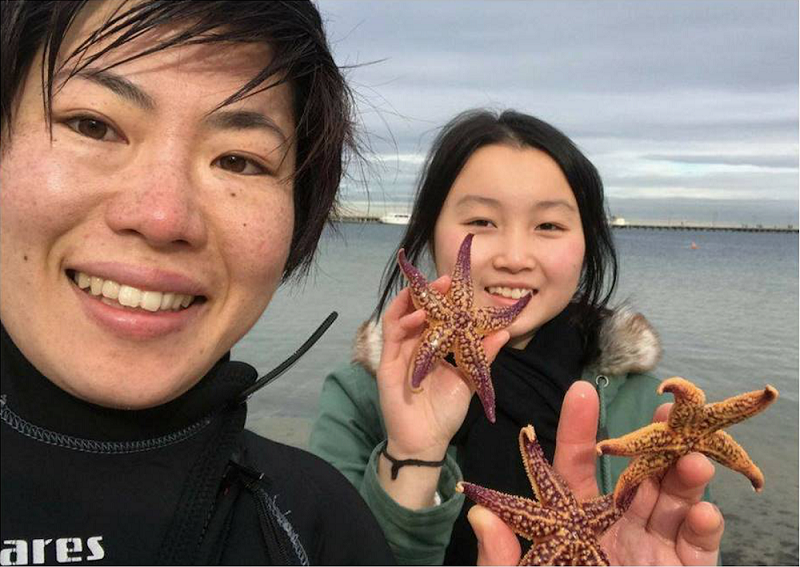
In addition to her EcoCentre work. Chenxin is involved in citizen science projects with RMIT University, the Dolphin Research Institute and Scouts Victoria. She is head of her school’s environmental club ‘Keen Green Beans’ and part of the Environment Committee.
She’s currently expanding a veggie patch at her school, running many hands-on workshops for student engagement in conservation and has established the Mac.Robertson’s Roots and Shoots Program, created by world famous primatologist Dr Jane Goodall – who she was selected to meet when Dr Goodall toured Australia this month.
Rather unsurprisingly, Chenxin hopes to study environmental science upon finishing high school.
Find out more about Chenxin and her work at the Port Phillip Ecocentre: https://ecocentre.com
Melbourne couple create massive international online marketplace to breakdown barriers to volunteering
A few years ago, keen environmental volunteers Matthew Boyd and Tanya Dontas from Melbourne’s Bayside quickly found themselves a little time poor.
There were so many worthy projects and causes they wanted to get involved in – but the reality of life and commitments meant they were often unable to give as much as they had hoped.
They did a little research and quickly realised they were not alone.
‘The current volunteering rate in Australia is 19%,’ Matthew said. ‘Both Tanya and I felt it should be 90%, but that things would really need to change to get there. The reality was, many opportunities were just getting far too inflexible for people to fit into their lives around work, family and study – particularly those aged 25-34.’
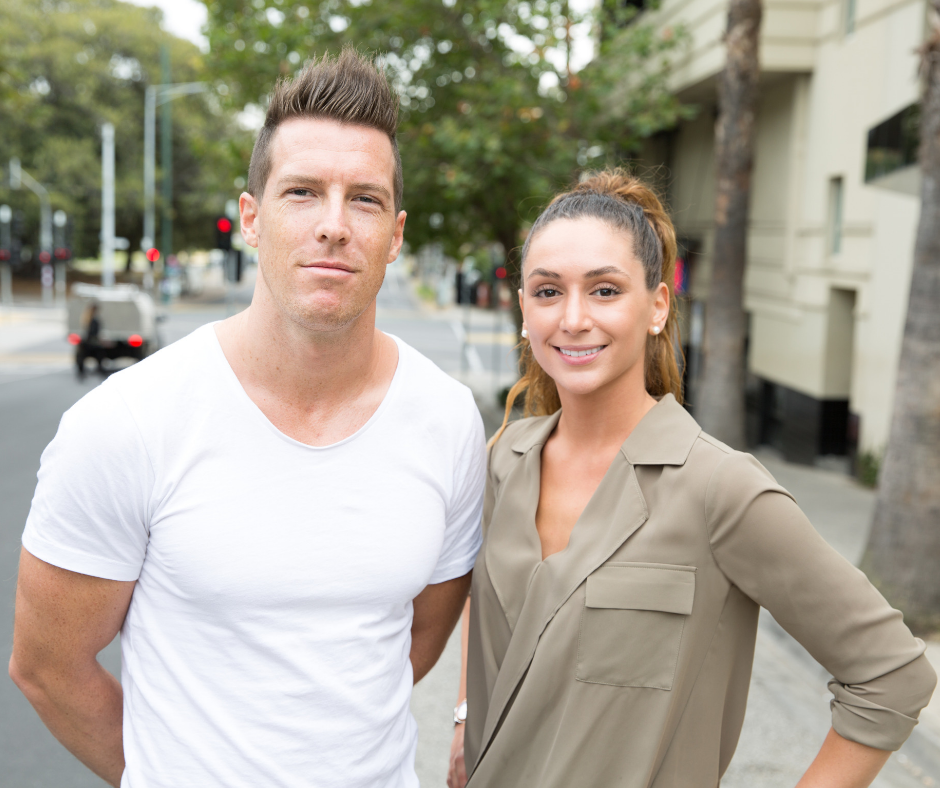
Delving a little further by speaking with a range of NGOs, it became clear that what these groups needed was often more than on-the-ground hours.
‘It was web developers, accountants, book keepers, lawyers, social media managers – all things that can be done by a skilled professional in their own time, at home,’ Matthew said.
The pair then created Vollie, an online marketplace that matches individuals to skills-based remote volunteering opportunities. The projects are delivered entirely online.
‘It’s like the AirTasker of volunteering,’ Matthew said.
In just 2.5 years, Vollie has grown from matching a handful of Australian organisations with willing volunteers, to delivering more than 520 projects via almost 10,000 volunteering hours donated by thousands of volunteers from Australia and around the world.
Earthwatch, Greening Australia, Greenpeace and People and Parks are among the environmental organisations now using the platform to attract online volunteers.
Environmental volunteering opportunities are incredibly popular, Matthew said.
‘From young people, to those time poor professionals in their 20s and 30s, there are so many people who want to and have those specialised skills that so many environmental organisations need,’ he said.
Find out more: https://www.vollie.com.au/
Volunteers spearhead skyrocketing enviro tourism among Victorian 18-35s
In years gone by, when young Victorians stored their leave for a holiday or long weekend, they often headed interstate or abroad for a quick Bali tour.
But a new wave of next-generation environmental volunteers is seeing many Victorians now spend their weekends much closer to home, for causes far exceeding a sore head or
sunburn.
Tim Trottier, 31, from Geelong is one of a team of team of volunteers with Intrepid Landcare. He helps lead environmental retreats for Victorians aged 16-35, and also brings young people to volunteer alongside him on various Landcare projects around Victoria’s west.
As a leader of the Geelong Intrepid Landcare group, Tim has helped young volunteers get involved in a range of current and recent Landcare projects.
This June, Tim and his young team will be planting 10,000 trees as part of an ephemeral wetland project with Barrabool Hills Landcare, providing a habitat for brolgas on a local paddock too wet in winter for cropping.
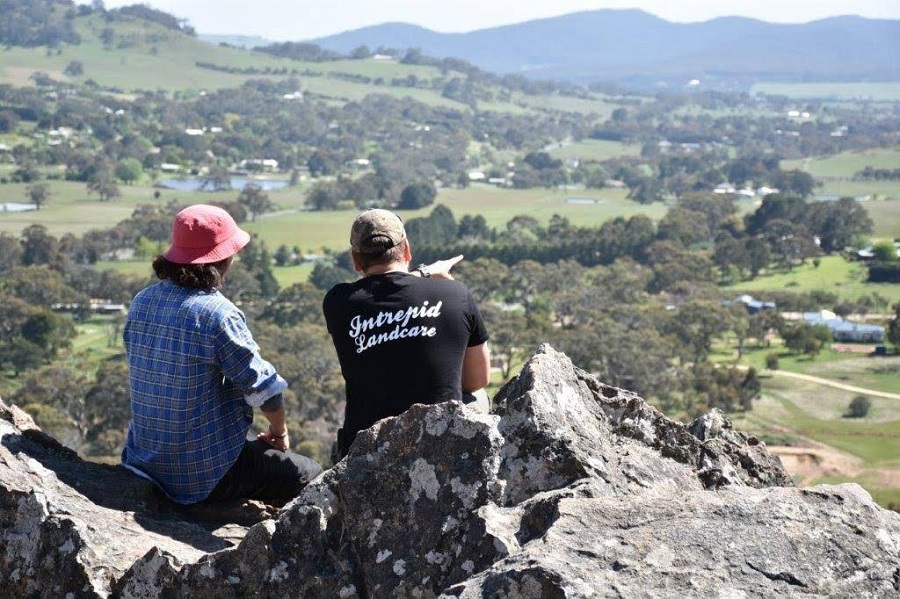
Picture: Intrepid Landcare volunteers at Mt Macedon
In 2018, they took a five-day ‘canoe and clean up’ tour down the Glenelg River on the Victoria/South Australia border, collecting rubbish along the way.
Tim also assisted with the Geelong Intrepid Landcare Retreat, a weekend away for groups of around 20 young people wanting to help the environment while learning leadership skills.
During a three-night retreat, participants volunteer on a local Landcare project, before attending a series of workshops and sessions run by Intrepid facilitators and local environmental leaders.
‘These retreats have really been amazing in opening up environmental volunteering to a lot of young people who wanted to get involved, but didn’t know how,’ Tim said.
‘A few years ago, we saw lots of environmental students, but now we have all kinds of young people coming and participating, from bankers to travel agents. They saw us on social media or heard a local ad and then saw how easy it was to get involved.’
The interest has since snowballed, with an upcoming Yarra Valley Intrepid Landcare Retreat attracting more participants than ever.
‘It’s also providing some succession planning for Landcare,’ Tim said. ‘It’s much easier to get a group of people from a retreat to be comfortable to go and join a local Landcare event together – something they might not have done alone.’
Find out more: https://intrepidlandcare.org/
5,100 Victorian properties and counting – volunteers like David and Susan restore 165,000 ha of wildlife habitat
When David and Susan Rowbottom from St Helens in Victoria’s west head out on their farm, they come across many more animals than their 6000-head of sheep that make up the Rowensville Ultrafine Merino Stud and the Wingfield White Suffolk Stud.
For (more than) around 20 years, the Rowbottom’s farm has been a certified Land for Wildlife property – and is now one of 5,101 across the state.
DELWP’s Land for Wildlife program facilitates voluntary agreements with private landholders to manage and restore habitats for wildlife on their property, many of which are working farms.
Since the program began in 1981, volunteers have restored or retained 165,000 ha of wildlife habitat – put together, an area roughly the size of Victoria’s Alpine National Park.
For David and Susan, the impressive numbers hit a little closer to home. Their farm neighbours the St Helens Flora and Fauna Reserve, with about 5 acres of (the) bush (running) next door on their property.
‘The bush there is incredibly unique and very special. It’s almost all that remains of land like it around here, as (most of) it was mostly all cleared (when) by the time I was (just) a teenager,’ David said.
‘When we took on the farm, I always knew I wanted to preserve our section of bush just as it was.’
Through the local community, David heard about the Land for Wildlife program, and enquired if his farm would be eligible.
Fast-forward 20 years, and the Rowbottoms’ dedication to preserving and protecting the land is more than paying off.
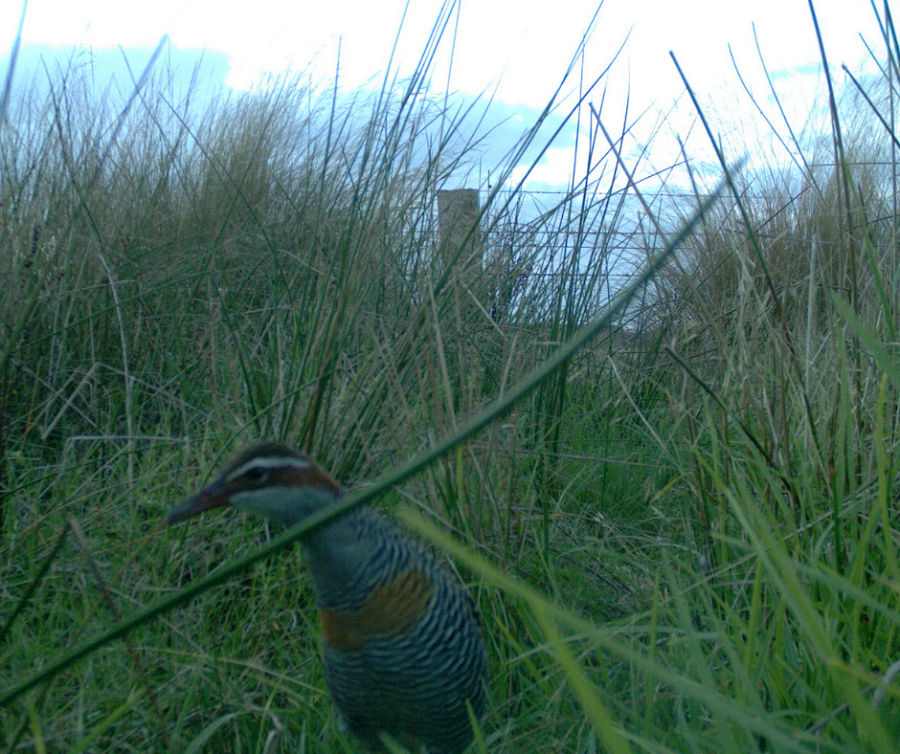
Picture: Buff-banded Rail
‘We now have the endangered Southern Brown Bandicoot here, around 60 species of birds either living or visiting the area, sugar gliders, three species of kangaroo, lots of echidnas, (and) possums, and marsupial swamp & bush rats’ David said.
‘The local Landcare (leader) facilitator is here about once a fortnight, recording and monitoring what’s going on, proving the species existence with the remote cameras’.
‘For me, I just love getting out there and walking around. The things you see – it really makes it worthwhile.’
David and Susan said they would encourage anyone who was eligible to get involved in the program.
‘Regardless of how small it may seem, when we look at what’s happened here over 20 years, it really actually is significant,’ David said.
Find out more: Land for Wildlife
Protecting Melbourne’s Insta-famous pink lake: Volunteers mix conservation with crowd control
When Westgate Park’s lake turned hot pink this February, it quickly trended as Australia’s hottest Instagram destination.
But behind the tens of thousands of social media selfies, a small team of dedicated environmental volunteers quietly toiled to protect this incredible wetland on the city’s doorstep.
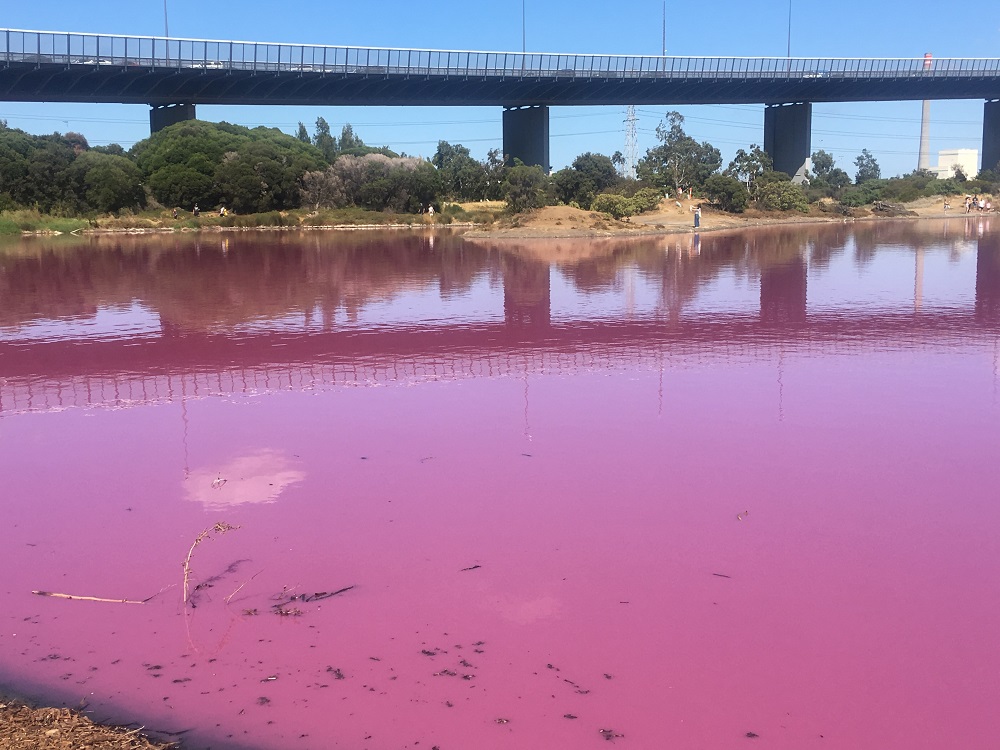
Around 20 volunteers with the Westgate Biodiversity Bili Nursery and Landcare group suddenly found themselves in scenes more reminiscent of a daily, never-ending music festival, than a quiet inner-suburban park.
Together they clocked around 1500 volunteering hours in March, alternating conservation with crowd control.
Westgate Biodiversity’s manager David Sparks said the task was far greater than their three paid staff could manage.
‘Some days it was 1500 people, 1500 the next, it kept coming and rising,’ David said.
‘We have a great group of volunteers who work with us year-round on conservation and re-vegetation across 40 hectares, and suddenly it was all hands on deck doing all manner of tasks.’
Volunteers began producing signs for visitors, explaining what they knew about why the lake was turning pink (high heat, low rainfall is the start of the process), and collecting rubbish in every spare moment.
They worked to keep people from standing in the lake and tried to protect native vegetation against the crowds. Unfortunately and despite their best efforts, much of the recently planted saltbush was trampled and destroyed.
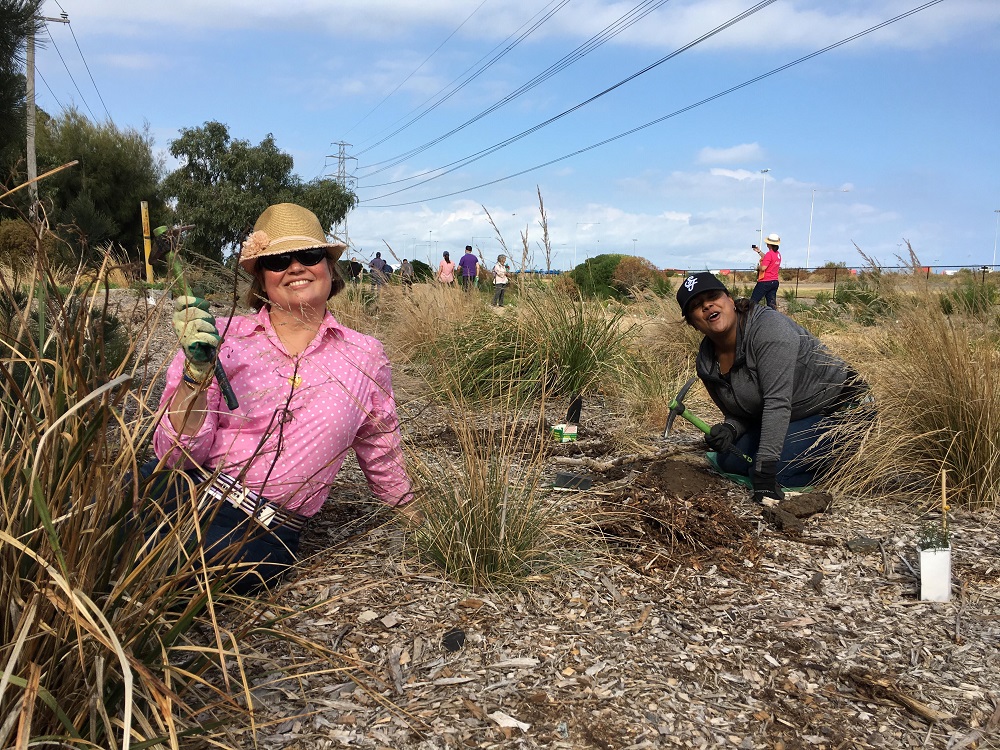
And while the impact on vegetation was upsetting for David and his group, the pink lake’s popularity has provided huge opportunities for the park to educate visitors more broadly about nature and conservation in the future, he said.
‘We’ve got 150 species of birds here and amazing plants we’d love for people to experience while they’re here,’ David said.
‘And because it’s likely that the lake will turn pink again next year, we’re now sitting down with Parks Victoria to look at a way forward. This includes possibly building a boardwalk to protect the vegetation, improving signage about the lake and its colour process and creating other designated visitor facilities and areas.’
Find out more: Westgate Biodiversity Bili Nursery and Landcare group
Volunteers help Aboriginal kids continue to connect to country and thrive
For the past seven years, Nalderun - an Aboriginal-led collective around Castlemaine - has been inspiring the next generation’s connection with country.
Nalderun - a Dja Dja Wurrung word meaning ‘altogether’ - operates holistic education, health and cultural services, including The Meeting Place.
Once a fortnight, participating Aboriginal children from right across the Mount Alexander Shire are bussed from their schools to The Meeting Place in Yapeen.
There, students aged from five up to 16 learn about the local Jaara Jaara knowledge and Aboriginal beliefs, and complete activities that are culturally enriching in line with the Australian Curriculum.
Run by two Aboriginal Elders and Aboriginal Coordinator, Kath Coff, Nalderun is supported by a dedicated team of four volunteers.
‘It’s all about continuing to connect our children to country and in doing so, inspiring them to succeed,’ Kath said.
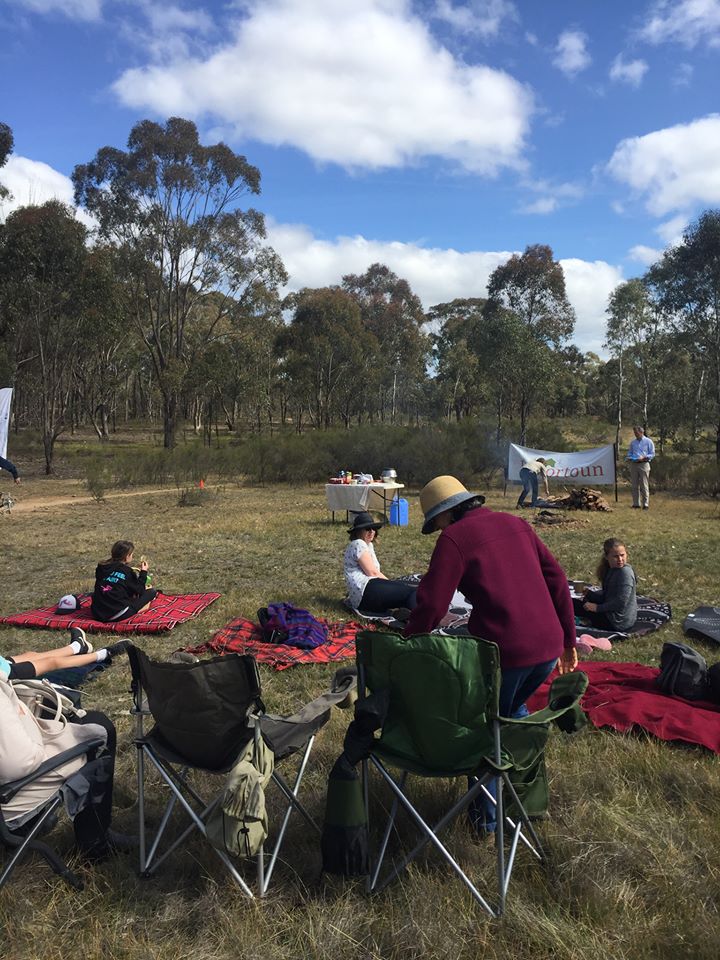
Nalderun also run a daily Koorie Bus that collects local kids to take them to their schools, and hosts a range of other community programs. These include ‘Men’s and Women’s Business’ events that take Aboriginal and other Australian men and women into the bush to learn about Culture and Connection to Country, and also a Bush Tucker Course that teaches people how to plant, grow and cook Indigenous foods.
‘We wouldn’t be here doing what we do without our volunteers,’ Kath said.
‘They are absolutely vital to what we do and they are in for the long haul with us, sticking with us to make meaningful and lasting change.’
Continued connection with country is critical to kids’ growth and success, Kath said.
‘Already this year we’ve got two kids going into school-based apprenticeships, including one with the local Catchment Management Authority,’ she said.
Find out more: https://nalderun.net.au/
Volunteers help keep Barwon’s river beaches safe for swimming
As Bellarine beaches attracted more and more families last summer, the Barwon Heads community became a little uneasy.
A stormwater drain, adjacent to a popular kids swimming beach, where the Barwon River meets the ocean had been significantly enlarged.
‘There are two beautiful sandy river beaches on each side of the river there which are shallow and really popular with young families,’ Barwon Heads resident Colin Bridges said.
‘We were worried that the untreated storm water may be damaging the water quality where all these kids and toddlers were swimming.
‘We know kids are particularly vulnerable to picking up and fighting off bacteria, so we wanted to know if there was anything the community should be worried about.’
As a local community association member, Colin volunteered with a program established by the Corangamite Catchment Management Authority to test the water quality as part of the Barwon Estuary Monitoring Pilot Project.
For the past 6 months, Colin and a team of 15 volunteers have been collecting water samples at the same time each fortnight at 8 different sites along the Barwon Estuary.
After each 1.5-hour collection, they place their samples in a cool box that is immediately couriered to a Geelong laboratory.
The last samples were taken in early May, and Colin and his fellow volunteers are now awaiting a scientific report detailing the findings.
Some samples have showed significantly raised bacteria levels at some of the collection sites, Colin said.
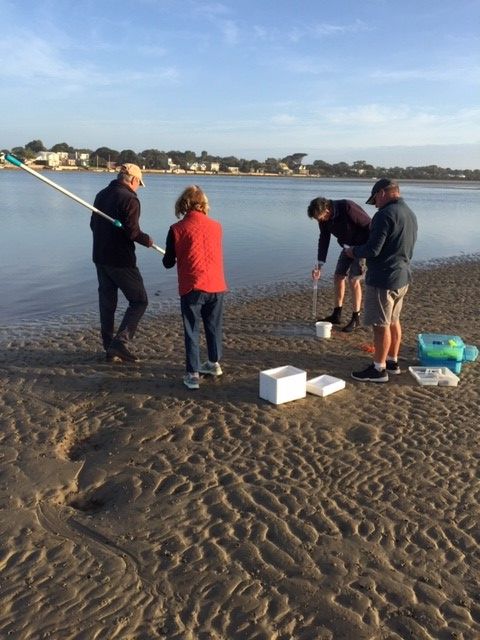
‘Once the final report comes out, we will know whether there is a need for a more permanent program, like the Port Phillip Beach Report, which provides warnings to Melburnians about where not to swim, including after a storm in Melbourne,’ he said.
Colin, 74, said being involved in the water monitoring pilot project, and volunteering with numerous community groups, had helped him make friends and build connections when he permanently moved to Barwon Heads four years ago.
‘It’s a very active community, there are so many different groups and things to do, and I love living here and doing what I can to help out,’ he said.
Find out more: Barwon Estuary Monitoring Project
Volunteers lead worldwide Repair Café movement across Victoria
John Hillel from Mt Waverley has long been a tinkerer, but for the past two years he’s been taking his fix-it skills far beyond his garage.
Since 2017, John has been running the St Kilda Repair Café at the Port Phillip EcoCentre.
From 2pm-5pm on every second Sunday of the month, John and a group of around 10 volunteers equipped with their tool boxes open the Centre’s doors to a line of locals clutching their broken toasters, hair dryers, clocks, torn clothes, jewellery, toys and an assortment of household electronics.
Over the afternoon, the volunteer group fly through up to 50 repair jobs, breathing life back into household items that otherwise would have been headed for landfill.
‘It’s a concept that started a few years ago in the Netherlands and has become very popular in Europe,’ John said.
‘It really resonated with me because it’s just so obvious that we need to make our planet more sustainable and we’ve got to start taking unnecessary waste much more seriously.’
Through contacts, John found out about Victoria’s first repair cafe in Yarraville, and began volunteering there. He quickly realised Melbourne’s populous southeast could also benefit from the service.
With the support of the Ecocentre and Melbourne’s Jewish Ecological Coalition, the St Kilda Repair Café was born.
There are now 30 volunteers now on the books – from electricians to academics and people who just like fixing things – who all chip in on a Sunday when they can.
Every month, they save more and more perfectly good household items from the scrapheap.
‘We have to stop this culture of if something’s broken, throw it away – that just doesn’t need to be the case,’ John said.
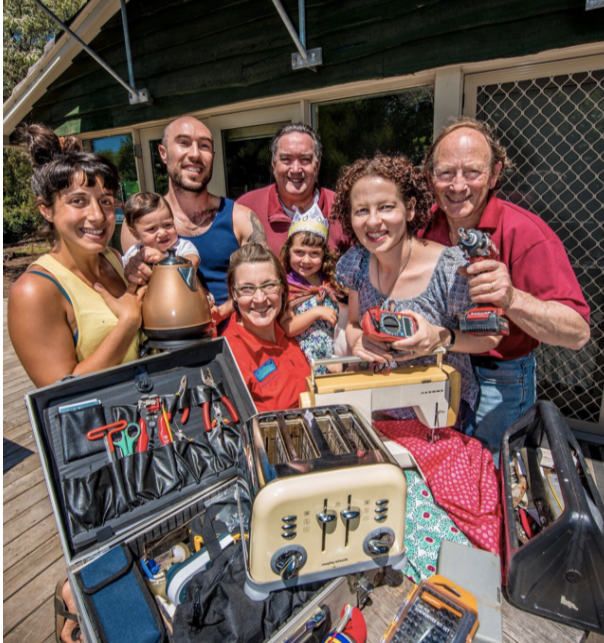
Victoria is now home to 21 repair cafes – the most in Australia. John recommends volunteering with a café to anyone.
‘It’s just a few short hours, nothing in the course of the month, but you get so much out of it. I really enjoy it,’ he said.
Find out more: St Kilda Repair Cafe
Reaping the benefits of community-based volunteering
Carmen Bush is a well-known face around volunteer groups on Phillip Island, recognised this week for a decade of volunteering with Phillip Island Nature Parks.
Her efforts in environmental volunteering on Phillip Island are grounded in close to 40 years of contribution across committees and grassroots community groups throughout her lifetime. Carmen knows the value of a healthy environment and ensuring we protect our biodiversity and reiterates the social and wellbeing rewards that her efforts reap. “We all need to work together to protect what we have”.
The sitting President for the Rhyll Coast Action Group, Carmen like many others began her journey by learning about native plants through gardening. A staunch advocate for coastline protection, she continues to build on this knowledge to contribute to revegetation efforts and wage war on invasive weeds around the Ramsar site on the edge of Western Port – an internationally recognised wetland.
Collecting seed from the remnant bushland, Carmen also volunteers with others at the Barb Martin BushBank, supporting propagation of native and indigenous flora from the Island ready for planting.
Carmen’s determination to restore degraded shorelines has also led to a partnership with Phillip Island Nature Parks, supported by a CoastCare grant to revegetate coastal woodland at Pleasant Point. This project aims to increase biodiversity, mitigate erosion and landslide and of course encourage others to get involved in environmental volunteering.
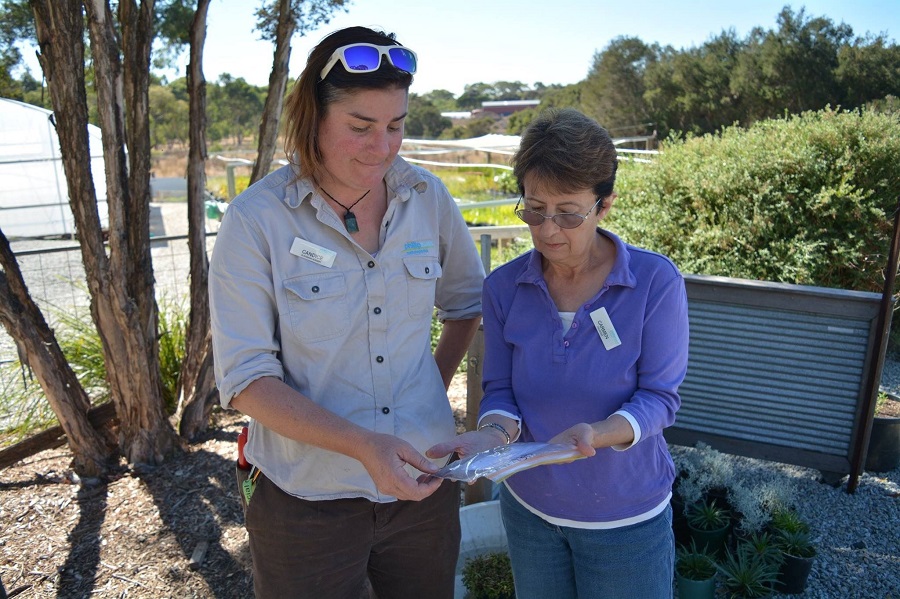
Photo: Carmen (right) with Candace, the Bush Bank Coordinator (left) looking at seeds from a 150 year old gum tree.
Carmen reflects on a recent planting session where the crew witnessed a magnificent sea eagle resting on a tree above them. “There is a real social and wellbeing aspect to these efforts – keeping fit, being in the outdoors and socialising with other community members.”
Carmen acknowledges she feels very lucky to be a part of it all, including the challenges and variability of the work, which is why she is also motivated to recruit others to join and contribute. “You have to work as a team - you’re always a part of something bigger”.
Having not yet exhausted all the environmental volunteering options on the island, Carmen can now be found volunteering at the Koala Reserve, connecting with visitors and sharing her amazement with our sleepiest of Aussie icons.
Page last updated: 18/03/24